Legacies


















Opening doors.
Unlocking possibilities.







































Opening doors.
Unlocking possibilities.




















 By Blaine Stephens, Board President
By Blaine Stephens, Board President

This is our year! On behalf of the Hammer & NER Board of Directors, we are so excited to celebrate not one but two coinciding anniversaries this year: the 100th anniversary for Hammer Residences and the 50th anniversary for Northeast Residence (NER). What an adventure it has been for both organizations as they have just recently become one.
In 1923, King Tutankhamun’s burial chamber was opened, Warner Brothers was established, and the first issue of Time magazine was published. Closer to home, Alvina Hammer opened Hammer School near Minnehaha Falls in Minneapolis.
In 1973, the United States signed the Paris Peace Accords ending involvement in the Vietnam War, Secretariat became the first Triple Crown winner since Citation (in 1948), and the Sydney Opera House opened. Closer to home, Northeast Residence, Inc. became a 501(c) (3) nonprofit organization.
From the start, both organizations shared a common vision to provide care and services in a “non-institutional” setting for people living with developmental and intellectual disabilities. Both organizations started from humble beginnings.
Hammer grew from a single location to a larger home on Dupont Avenue in Minneapolis, then to two duplexes at Humboldt Avenue and Lake Street. By 1929, Hammer needed more space for children to roam and play, so the Drew property, outside Wayzata, was acquired by paying off back taxes on land that had been home to
Swanson’s Nursery and the Minneapolis Gun Club. In 1960, Hammer Residences was incorporated and approved as a 501(c)(3) nonprofit organization.
In 1971, a group of dedicated and caring people in the northeast metro, who worked with children with developmental disabilities, had a vision. After two-and-a half years of pure determination that vision was realized. Northeast Residence, Inc. was originally envisioned as a temporary setting for teaching life skills such as dressing, eating, and toileting. However, by the end of the first year, the mission changed to long-term care and eight children moved in. The home was located at the old St. Mary’s convent in White Bear Lake. The local Lions Club, businesses, community churches, and other organizations provided what the new home needed to get started.
In the 1980s, the push for deinstitutionalization led both Hammer Residences and Northeast Residence to realign and move into supported community-based homes.
In 2020, amid the COVID-19 pandemic, Northeast Residence approached Hammer Residences to join forces. We believed that we could be better together. On January 1, 2021, NER was acquired by Hammer Residences, and we began to merge the two organizations, making us one of the largest nonprofit disability services providers in Minnesota.

We continue to be inspired by our founders’ passion for innovative services. We currently support nearly 362 adults who reside in 59 group homes and nine apartment programs in the Twin Cities. We also provide case management services to over 1,370 individuals and families to help them plan and connect with resources. And we continue to learn how much better we can be together.
Please join us in celebrating our past, supporting our present, and encouraging our success well into the future. Here’s to the next 100 years!

I was recently talking to a couple of co-workers about what life was like just three years ago. Back then, we were in the early months of the pandemic and meeting every day to try and understand what was happening and ensure that we kept everyone safe. It was a wild and stressful time for all of us. Now that COVID-19 has receded a bit and become part of the landscape of life, we can begin to evaluate what we have learned and what has changed.
The world has changed in significant ways. The truth is that these changes were happening before COVID. The pandemic simply sped them up and highlighted them.
The workforce was already changing. Many more people were retiring than entering the workforce. Immigration was at an all-time low. Technology was making it possible to work remotely and the gig economy was changing the nature of work. Through all of that, we remain a “person”-intensive workplace. Technology cannot replace a well-trained and motivated worker providing needed support on a daily basis. Our field, and others like it, has traditionally been a place where immigrants have entered the American workforce. It is not possible to provide the support needed in a “gig” model of moving in and out of the workforce. We need a steady and reliable workforce that is always present.
Hammer & NER has faced significant challenges before. The secret in all of them has been to embrace the reality of the situation and think creatively about our response. Pre-pandemic, we started to change how we train and deploy our workforce. We began to think creatively about how to provide support in a more fluid reality. We embraced technology in those places that it can help provide better service. We advocated at the legislature for more funding that could be passed on to our Direct Care workforce. We raised our minimum wage significantly (it is not enough yet and we continue to work toward further increases). We added incentives where we could. We increased our fundraising, as that is the money we have more control over.
John Estrem was named CEO of Hammer Residences in 2011. He has led the organization through significant challenges and growth during his tenure including the recent merger with Northeast Residence and the COVID-19 pandemic.
Most significantly, Hammer & NER merged into one organization. We were both committed to providing creative and quality services. We knew that we would be better together and that has been proven true. Our larger footprint gives us more influence at the legislature and opens new and important fundraising avenues. It also expands our horizons and the possibilities for creating our future.
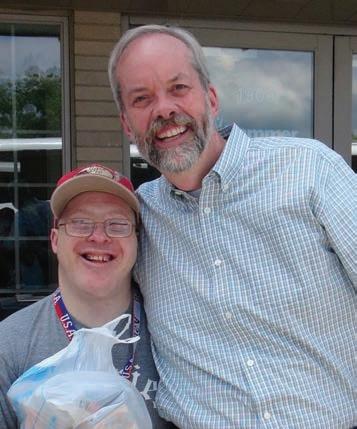
I believe strongly that the future is bright and that we will continue to be strong. As with all periods of change, there will be bumps along the way. Our model of embracing reality, being creative, and doing what we do in partnership, means that we thrive in times of change. At times it is scary, as it is natural to prefer what we know.
As we worked through the merger, we adopted the phrase, “Better Together.” While it initially referred to the two organizations becoming one, it has a deeper reality: In order to face—and thrive in—the future we need to stand together. No one person (or group) holds the key to the future. Standing together, we discover that key as we move forward.
This publication primarily focuses on the past and how we got to where we are today. However, it is not just a nostalgic walk through the past. It teaches us that we have and continue to face the future with courage, determination, and creativity. As long as we stand together, the future is always bright.

Since 1923, Hammer’s mission has been to provide innovative services that enable people with developmental disabilities the opportunity to lead meaningful, self-directed lives. Here is a look back at Hammer’s leaders and how they have worked to sustain the mission and help it thrive.
1923-1947 – Founder, Alvina Hammer: When it came to caring for people with developmental disabilities, Alvina Hammer’s ideas differed radically from society in the 1920s. Instead of institutionalization, Alvina believed that all people had the right to lead lives in a loving atmosphere where they would feel secure and develop self-confidence. Now, 100 years later, we continue to draw inspiration from Alvina’s passion for innovative service. (Learn more about Alvina on page 8.)
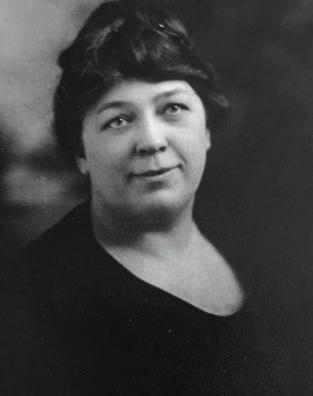
1947-1974 – Director, Gertrude Evelyn Carlson: Evelyn came to Hammer School in 1932 as a teacher, but she did much more than just the work of a teacher. Later, as Alvina Hammer became unable to continue, Evelyn became the guiding hand. Hammer expanded under Evelyn’s leadership. During her tenure, she acquired additional property, implemented new programs, and added a significant number of new individuals and family members. She guided the creation of state-of-the-art dormitories, group homes, and apartments that became home to 72 individuals.









1974-1985 – Executive Director, Merlyn Larson: During Merlyn’s tenure, the original Hammer School was torn down and replaced with a central office and family gathering and dining area. Hammer helped to form ARRM, a trade organization of providers who worked together to improve services for people with developmental disabilities. In 1978, Hammer School became Hammer Residences, Inc., relinquishing formal education to local school districts.

1985-1991 – Executive Director, Roger Deneen: During the 1980s, Hammer embraced the emerging idea that people with disabilities should be integrated more fully into the community. In 1986, under the direction of Roger, the Board of Directors voted to close the dormitories and move individuals into Hammer-owned group homes.


The first home was opened in 1988, and the movement from the dorm setting to homes occurred at a rapid pace. However, this change brought significant financial challenges as our funding sources changed dramatically for the new waivered services. Roger championed working with the Department of Human Services and the legislature. Despite the challenges, he was dedicated to giving those we supported the opportunity to live in the community.
1991-1998 – CEO Jon Thompson: Jon worked to refine operations, stabilize Hammer’s financial affairs, and implement a management model to bring strength to the group homes. The new model created the roles of Program Directors and Program Managers with the latter managing the daily operations of each home. He also enhanced communications and management through the purchase of computers and expanded use of technology. Jon also believed in developing partnerships with other providers to expand living, working, and recreational opportunities for the people supported by Hammer.








1998-2011 – CEO Timothy R. Nelson: Tim had previously been a Program Director at Hammer. He joined the organization in 1977 as a Resident Counselor on the men’s floor of the dormitory. His passion for the work was organic. He had a brother with developmental


disabilities who came to live at Hammer. Tim led Hammer through times of serious budget cuts and government shutdowns. Despite this, he focused on quality and growth to improve services to a growing number of families in need. With Tim’s leadership, Hammer’s influence reached state and national heights. His advocacy always included his belief that people with disabilities should be given the same opportunities that non-disabled people have to live satisfying and productive lives. Tragically, Tim died very unexpectedly in August 2011.
2011-present – CEO John Estrem: John was hired to lead Hammer into the future. John has passion for those we support and has worked with people with disabilities throughout his career. Having been a CEO previously, he brought a different way of looking at things. However, from early on he understood Hammer’s mission. John took the time to get to know the organization and its people. He led the organization in building our base—staff were being trained, families were being nurtured, and he ensured we were doing the things we cared about. In 2020, in the midst of a pandemic and critical ongoing staffing shortages, John guided Hammer through a merger with Northeast Residence, a like-minded provider in the northeast metro. The merger was finalized January 1, 2023. Today, Hammer & NER is strong and continues its dedication to walking alongside the people we support as they live life to its fullest.
Special thanks to Lisbeth Armstrong, former Chief Program Officer, for her contributions to this article. Lisbeth served as Interim CEO after Tim Nelson passed away. She retired in 2015 and resides in California.



Since opening our doors in 1923, Hammer’s passion to provide quality services for individuals with developmental and other disabilities has helped thousands experience life to its fullest. Founder Alvina Hammer believed that individuals with disabilities had the right to live in a loving atmosphere where they could develop self-confidence, learn, and grow. Alvina’s ideas differed radically from those of society at the time. In the early 1900s, families and communities were embarrassed and ashamed of their handicapped members; some called them names and hid them away. However, Alvina believed people with “mental retardation” had the right to lead lives as normal as possible and that if provided a loving atmosphere, they would feel secure and develop self-confidence.
As a nurse at the Faribault State Hospital, Alvina was impacted by the plight of people with developmental and intellectual disabilities. In 1923, Alvina rented a home near Minnehaha Falls in Minneapolis. She hired a teacher and began caring for and teaching four children with special needs. She added three more children and moved to a larger home on Dupont Avenue South. There were few classes available anywhere for children society deemed “feeble-minded.” As the news of the new Hammer School spread, families began bringing their children to Alvina and placing them in her capable hands.
Alvina married Herman Rutzen, a long-time friend. The Rutzens worked together to continue Alvina’s steadfast commitment of caring for the developmentally disabled. They purchased a piece of property in Wayzata with a large farmhouse to house Hammer School and the growing number of children it was serving.

Alvina retired in 1947 as her health was declining but continued to stay involved. She suffered a heart attack in 1959 and passed away in 1965.
Alvina’a great nephew, John Barnett, says, “Alvina was a pioneer. Her approach became the model for Minnesota. She devoted her life to that cause. The small seed Alvina planted in 1923 has grown into a huge organization in 2023. She would be totally amazed how her humble start to help a few children has grown into such a large organization helping so many.”





Evelyn came to Hammer School in 1932 as a teacher. She had been a teacher in a lumber camp in Manitoba, Canada under very harsh conditions that greatly impacted her health. She came to Minneapolis to stay with her parents. She visited an employment agency and heard about Hammer School. She interviewed and despite having no experience teaching children with developmental disabilities, she was hired and was paid $50 a month, plus room and board.
The early years were filled with hard work and little pay, but Evelyn loved her job. She assumed the role of Director and Proprietor of Hammer School in 1947. Under her guidance, Hammer expanded, acquiring additional property and implementing new programs. By 1960, Hammer School was outgrowing the property’s original home which was also in need of extensive repairs. Groundbreaking soon took place for Hammer School’s first dormitory. A second dormitory was built in 1966. In 1974, the final building on the Hammer campus was built—the Carlson House, named for Evelyn Carlson.


As a teacher of 15 years, Evelyn was a pioneer in the field of developmental disabilities and gave 52 years of extraordinary service, retiring in 1974. In addition, Evelyn influenced the growth of developmental disabilities services across the state. She was involved with Friends of the Mentally Retarded (which later became MARC) and played a part in the founding of ARC Minnesota, the Day Activity Center Council of Hennepin County, and ARRM (Association of Residences for Retarded in Minnesota).
Evelyn Carlson passed away March 18, 2000, at the age of 92. Tim Nelson, Hammer’s CEO at the time, recalled that, “Her faith, her skills, her stamina, were all tried through adversity, and she came out refined like gold.”








 By Ginger Venable
By Ginger Venable
Ginger joined Hammer’s Development team in 2012 and serves as our Event & Project Manager.
Ralph Rosenvold was a little fellow with eyes filled with merriment and good nature with a smile that cracked his round, jolly face. In a very special way, he was a symbol of Hammer around Wayzata, endearing himself to people for almost 65 years. Every day of the year, Ralph could be seen raising and lowering the American flag on campus. He was proud to mow the lawn, shovel snow, tend the garden, wash the dishes, do repair work with the maintenance team, and grocery shop.
“Big Shot,” was Ralph’s nickname. Was that because he was one of the very first students to move into the Hammer School? Or was it because Reuben Lindh, his brother-in-law, a strong advocate for people with disabilities, founded MARC (which later became ARC) in 1947. Ralph helped Hubert Humphrey dedicate the new dormitory, led the Boy Scout troop at Hammer School and was an active swimmer in the pool. He loved to entertain through his music and playing the organ and spoons (or “bones”). Or maybe they called him Big Shot because he was the hardest working person on campus.

Ralph volunteered at the Long Lake Nursing Home, shoveled snow on Lake Street in Wayzata, and bundled up newspaper whenever there was a paper drive. He bowled with the senior citizen league in Minnetonka with a high score of 177. Whenever Ralph was out in the community he made a point

of greeting everyone. Passersby were guaranteed a good day with Ralph’s friendly, “Hello!”
Ralph participated in the James J. Hill Parade every year. He was greeted with big smiles and waves from all of his friends in town.
In 1982, the Sun Sailor newspaper recognized Ralph as a super senior citizen and thanked Hammer for giving the community the blessing of “living outside itself.”
Ralph was one of Alvina Hammer’s very first students. His family paid $10 per week for him to

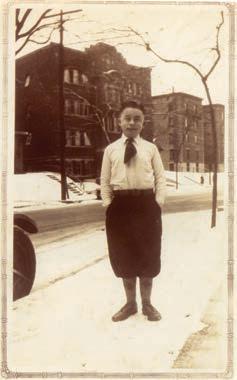
attend the original school on Humbolt Avenue in Minneapolis. He would walk from the Lindh’s home over two miles away to attend daily. He moved to the Wayzata home with Alvina in 1929.
Ralph achieved what many people could not. His love for people and acceptance of everyone he met is his legacy which lives on throughout the Hammer community today.










In 2000, when Hammer moved into new offices, we developed a legacy icon, named Ralph, to honor this long-time friend who embodies the mission of living life to the fullest. His spirit and this legacy represent individuals with differing abilities, who thrive in their communities living the life they deserve with the compassionate care we provide. Ralph lived a joyful life at Hammer and still inspires us all to reach toward the sky and strive for all that is possible.
The first Ralph statue was created in 2005. From left: Pat Houston, Ellen Timmerman-Borer, and Ruth Hogenson welcomed him fresh out of the mold!
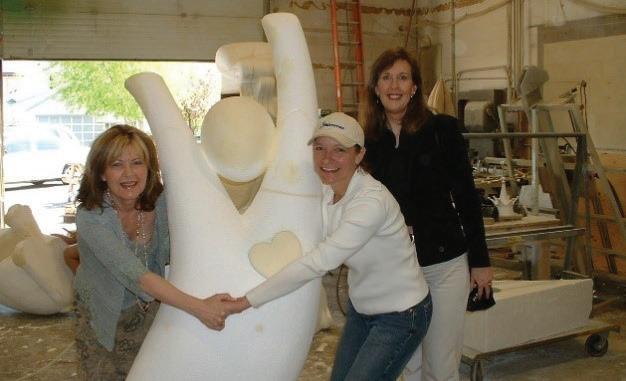
At Ralph’s funeral in 1995, his niece, Janis Carlson, sang a solo in his honor. Janis, her husband Marlan, their son, Barry, and wife, Debbie, actively support Hammer. They take great pride in the Rosenvold legacy of building communities that are inclusive for all.

Reach for Ralph, our annual fundraiser, invites the community to gather and celebrate all that Ralph stood for. Since the first event in 2010, Hammer has raised almost $3 million to support people served by Hammer & NER. The gold statues are given as honorary gifts to strong supporters: volunteers, staff, and donors. If you have a Ralph statue you know you are part of our family, extended.
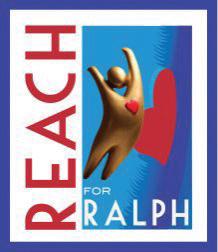
The Journey Begins

1923
1929
The Drew property, outside Wayzata, was acquired by paying off the delinquent taxes. The property was located on Superior Blvd., a two-lane dirt road which became Hwy 12.
1932
Evelyn Carlson arrived to teach at Hammer School. With a lack of teaching materials, Evelyn improvised, designing sight and hand recognition exercises for each student. Much of what she developed became tools and practices for teachers in the field.
1930s Late
Things began to improve. Parents once again brought their children to Hammer School. Applications came from all over the US, Canada, England, Mexico, and South America.
1950-60s
Hammer School continued to be a model program throughout the developmental disabilities field.










The Depression years were very difficult financially. Many families could no longer afford the $35 monthly fee. Alvina had to borrow $100 to purchase 2,000 lbs. of potatoes to get through the winter.
The War Years
1941-45
Finding staff was very difficult. For two years, Alvina, Evelyn Carlson, and Jenny Malmgren were the only staff.
1947
Alvina Hammer stepped down as Director of Hammer School. Although in declining health, she couldn’t leave the children she loved. She helped watch the younger children and did relief work as needed.


1947
Evelyn Carlson became Director of Hammer School and continued to expand by acquiring additional property and implementing new programs to grow Hammer School.
Family Day Picnic
1960
Architectural drawings for Hammer’s expansion were shared. Hammer School became a nonprofit corporation, and the first Board of Directors was established.
Ground was broken for Hammer’s first dormitory. The West Dormitory was dedicated by Sen. Hubert H. Humphrey.
1963
The Board approved the purchase of three acres from a neighboring piece of land which included a house and garage. The house, known as the Annex, later became Hammer’s first group home for women.
Source: The Story of Hammer 1923-1998 with special thanks to Marge Barrett. Thanks also to Rose Rizzi, our archivist, for her assistance. Rose joined Hammer Residences in 1975.
1966
Hammer School received a grant from the Kennedy Foundation to build a second dorm. Eunice Kennedy Shriver told Evelyn Carlson that Hammer was the first small residential facility in the country to be selected for the grant.
1974
The final building on the Hammer campus was built, the Carlson House, named after Evelyn Carlson. It had eight double apartments and a sixbed group home.
1975
The MN Legislature decreed that public schools must take responsibility for the education and training of children with special needs. As a result, Hammer contracted with the school districts in which its students’ families resided.










The Legislature ordered a moratorium on new intermediate care facilities. A new federal waiver provided for people with developmental disabilities to live in group homes in the community.
1986 Fall
Hammer closed the dorms and moved 46 residents into the community. It purchased several group homes, rented apartments, and closed Hammer School.
2020
Northeast Residence (NER) approached Hammer and suggested partnering. NER had been looking for an organization with similar values and beliefs and found it in Hammer Residences.
2021 January 1,
Hammer acquired NER, agreeing that we could be “Better Together.”
Hammer School Becomes Hammer Residences
1978
Hammer Residences, Inc., began focusing on residential programs designed to help people live successfully in the community.
The main building and dorms were demolished, and ground was broken for Hammer’s new Central Office, providing office space along with areas for the nursing team, employee training, and volunteer coordination.
2022 Fall
Hammer was recognized by the Star Tribune as one of the Top Workplaces for 13 years in a row!


Spring
2020
The COVID-19 pandemic impacted everyone. Our group homes and apartment programs adapted to life “sheltering in place” during statemandated stay-at-home orders.
2023 January 1,

The merger was official! Today, Hammer & NER supports 1,732 people living with developmental disabilities in 59 group homes, nine apartment programs, and through Customized Support Services.


 By Lin Curran
By Lin Curran
Lin Curran is Chief of Operations. She joined Northeast Residence in 1987 doing direct support and recently celebrated her 36th anniversary with the organization.
Decades ago, it was common for people with intellectual disabilities to be placed in state institutions or foster care early on before long-term group homes became part of normalization for them. Frank moved into Northeast Residence (NER) in 1975; two years after the home opened in downtown White Bear Lake in what was previously St. Mary’s convent. At the time, Frank was eight years old. Frank had been placed in foster care shortly after birth. He has lived in a NER home for 48 years. In 1979, Kim moved to NER from Cambridge State Hospital where she was receiving respite services. Prior to this she resided in four foster homes over a fouryear period.
Frank’s sister, Ruth, became his legal guardian over time and remains in his life. Yvonne, who was the supervisor in their home for many years, became Kim’s legal guardian after leaving NER. Yvonne was a big part of Kim’s life while she worked at NER and continues to be a huge support for her.

Around 1994, NER purchased a duplex in White Bear Lake for all nine of the people living in the convent to move into. This home had nine bedrooms—six on the upper level and three on the lower level. There was space for the NER office as well. In 2001, a home was purchased in Roseville which Frank and Kim moved into. Then, in 2016 a home was purchased in Maplewood—our Currie home— which was better suited for those with mobility concerns like Frank and Kim.

Throughout their 44 years of living together, Frank and Kim participated in many activities including vacationing at Camp Friendship and going to local beaches and parks. During the summertime in the late ‘80s and into the ‘90s, we would drive all nine people to a park and/or beach to grill out a meal and play in the water. Frank would often sit and observe others while Kim would play in the water and sand on the beach. Staff took great pride in making sure the people supported were given opportunities to have experiences within their community.
Over the years, Frank and Kim have slowed down as many people do as they age. Staff have always looked for things they can participate in. Frank enjoys sitting outside in the sun people watching and Kim enjoys manipulating sensory objects, listening to music, and people watching.


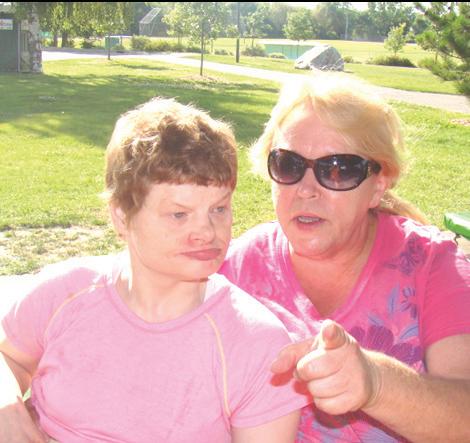
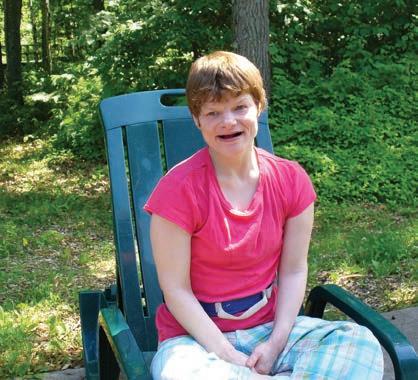
This past year Frank’s health has taken a turn and he has been hospitalized a few times. Currently, he is in hospice care within his home at Currie. The staff continue to provide as much leisure time as possible for him to enjoy, including sitting outside on warm sunny days. Slight changes have happened in the home to accommodate Frank’s and Kim’s changing needs.
As we celebrate this 50-year anniversary for NER it is nice to know we continue to be one BIG happy family as well as family, extended.
Editor’s Note: On the evening of July 6, 2023, Frank passed away peacefully in his home surrounded by people who cared for and loved him. He will be deeply missed.


Sue Walker is Chief Program Officer and joined Hammer Residences in 1977 doing direct care. She met James, our longestsupported person, and eventually became his guardian when his family were no longer available.

James came to Hammer in 1948 when he was 11 years old. He had been living in an institution in Rockford, Illinois where he had a few relatives. They stayed in contact with him throughout the years by sending letters and gifts on holidays and for his birthday. He was very fond of his family and talked about them often.
Most of the medical advice at the time was to place children with disabilities in state institutions. It was very brave of his family to seek out and send James to a community-based home. There were other children whose families


took the same bold step. In those earlier days, several children moved to Hammer from out of state because their families thought that this placement would be a more nurturing and loving environment. When James came to Hammer, he lived in the “old Hammer house,” a large farmhouse with a porch; one of his favorite spots.

I first met James in 1977. We were sitting in the living room at the Annex (formerly on the Hammer property) and James wrote my name down in his notebook. He has so many fond memories of people who lived and worked at Hammer over the 75 years he has lived here. He has said it feels like home, like family. He can recall Hammer’s Family Day Picnics, women he had a crush on, details about various staff, and school and work experiences from many years ago. He loves trucks and heavy equipment, holiday decorations and fireworks, and a cold iced tea on the porch in the summer. He gets teary-eyed sometimes looking at pictures from the past. He is a treasure!
One of my favorite memories with James is going to the State Fair. James always likes to visit the KOOL 108 radio booth. He loves radio personality Johnny Rocket. One year, James got to meet him and was invited into the radio booth during a broadcast. The next
year we went back, and Johnny Rocket came out to say hello. He remembered James’s name and gave him a big hug. James was just beaming.

Today, James lives at our Carlson home. He is 86 years old. He really considers Hammer his “second family.” He feels that many of the people he has lived with over all these years are his true friends. He likes all the typical daily tasks and activities that you do together as a family – meals, visiting, holiday and birthday celebrations, doing things in his community, and shopping at the local businesses. He feels that the staff who have cared for him have really provided him with a sense of security and support. The relationships are so meaningful to him.
We sometimes don’t stop to think how significant these things are to James and the others we support at Hammer & NER. But when one doesn’t have family nearby or they have passed away, it is so important to know that others desire to have that relationship with you. James knows that he needs help to do many of those simple daily tasks and navigate social situations. He wants that support and reassurance that people care so much about him and are there for him.
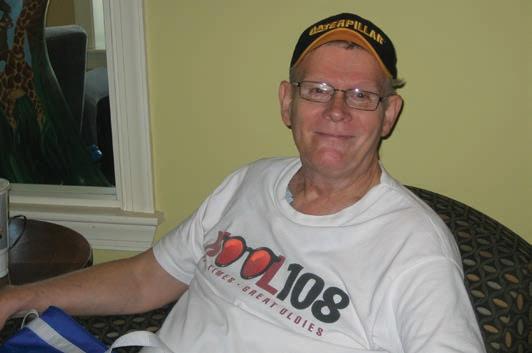


What a blessing that James has been able to live and work in this community. He so appreciates his life and the people who love and support him.


1971 – A group of dedicated and caring people who worked with children with developmental disabilities wanted to create an opportunity for them to live life to their fullest potential through experiences, choices, and selfdetermination. 1994 – NER begins opening additional community-based homes. NER opened the first of these new homes in Ramsey County along with a duplex in White Bear Lake for all nine of the people living in the convent to move into.
Sept. 1973 – Northeast Residence Inc. (NER) was incorporated and approved as a 501(c)(3).












NER opens a group home for children in the old St. Mary’s Church Convent in White Bear Lake.
1973 – A respite-care room was also incorporated, a new idea that did not fit existing regulations, but the County was supportive.
1977 – A second facility, a home on Oak Knoll in White Bear Lake was opened.
NER Executive Directors & Administrators
Jacqueline Sailer Founding Director, 1973-1978
Patricia Broen Acting Director, 1978
John B. Kruse Director, 1978
Tom Peterson Director, 1980 -1982
1996 – NER opened its first after-school program (the first of three) at an apartment in Shoreview.
September 2000 – NER built a second respitecare program following three years of fundraising from corporations, foundations, civic organizations, and individuals.
Jane Wells Acting Director & Administrator, 1982-1984
Pattie Butcher Administrator & Program Director, 1984-1987
2009 – The state issued a moratorium on opening new waivered group homes. Fortunately, NER was able to open three additional homes before the deadline.
2014 – Executive Director Corrine Schmidt retired after 28 years of dedicated service.
November 2018 – NER staff and the adult day program moved into a new office building in White Bear Lake. The 24,000 sq. foot building also provided extended day care for adults and kids.
Mary Jo Dolan Director, 1987-1988
Paul Buys Director, 1988-1990
Corrine Schmidt Director, 1990-2014
Heidi Holste Director, 2014 -2020
November 2019 – The respite program closed due to ongoing staffing shortages. NER had to focus on maintaining staffing at its long-term care homes.
Summer 2020 — NER began discussing the need for a merger as staffing was a huge concern and approached Hammer.
January 1, 2021 – Hammer acquired NER, agreeing that we could be “Better Together!”
January 1, 2023 – NER celebrates its 50th anniversary and a new beginning as the merger with Hammer Residences is complete.
Eric Schnell Interim ED, 2020
John Estrem CEO, 2021 - present Hammer & NER
By Corrine Schmidt and Lin Curran
 By Angela Bernhardt, Director of Major Gifts
By Angela Bernhardt, Director of Major Gifts







Angela Bernhardt grew up in Wayzata and as a result, she has been familiar with Hammer all her life. She joined Hammer in 2013 as the Director of Major Gifts and enjoys meeting people and learning (and sharing!) their stories.
Ann Brennecke Tulloch was instrumental in the development of Northeast Residence and served on the NER Board for many, many years.
She was tirelessly devoted to her son, Robb, who lives in a NER home and to the staff who care for him who she took the time to get to know on a personal level. When people talk about the impact Ann had on NER and their own lives, they often become extremely emotional. Ann gave extra to everything she did and stood out in her level of involvement.
Ann was always grateful, gracious, and thankful to those who shared her passion for children and adults with developmental disabilities.

“Ann Tulloch was the humble, quiet gift that keeps on giving,” says Lin Curran, Chief of Operations. “When she was with us, she would quietly show up at the home Robb lived in and remove weeds from the yard or beautiful flowerpots would magically appear. For fundraising events, she was always available to bring in gifts for the silent auction or simply help in the background. When ideas were needed, she would sit with you and brainstorm. No matter what the need or ask was, Ann was always there.”
Ann passed away in 2019 at the age of 74 after a three-month struggle with an aggressive metastatic cancer. Memorials were directed to NER and 77 donors contributed $60,350 to her memory. Ann created a lasting legacy with her time, energy, talent, and financial commitment that continues today.



 By Marge Barrett
By Marge Barrett
Marge Barrett’s sister, Patty, was part of the Hammer family for 47 years. Marge recounts fond memories and a little Hammer history.
My eight-year-old sister, Patricia Jane Rogers, entered the Hammer family in 1961 when our family moved to St. Paul. My parents, who believed children with Down syndrome could learn to read and write and be part of a larger community, chose to place her at Hammer Residences because of its reputation. Patty stayed at Hammer the rest of her life. During those 47 years, my family never missed performances, fundraisers, Family Day Picnics, Annual Meetings, and State of the House meetings. Patty came home for weekends, holidays, and summers.

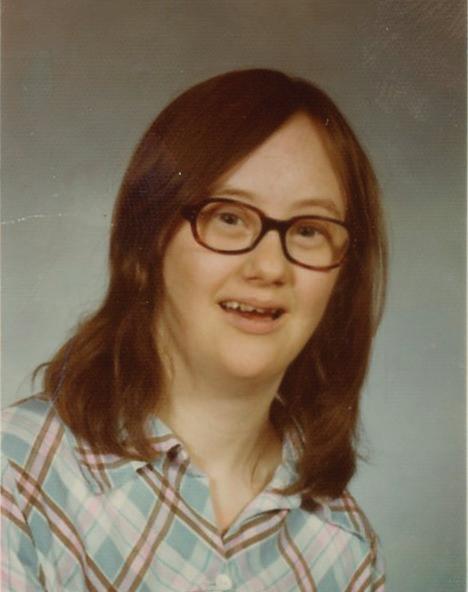
My father served on the Hammer Board of Directors when Patty was a girl, and I served on it when she was a young woman. During my tenure, I wrote The Story of Hammer, 19231998, marking the 75th year of the organization. I learned that in the 1920s, Alvina Hammer couldn’t forget the people with developmental disabilities she had met as a nurse at Faribault State Hospital. Rejecting the prevailing cultural attitudes of the times, that the “feeble-minded” could not be taught and should be separated from communities, she hired a teacher and rented a small house near Minnehaha Falls in
Minneapolis. The two of them cared for and taught four children with special needs.
In 1929, Alvina bought a large piece of land outside Wayzata so she could continue expanding programs and housing. She supervised an addition built in 1934: a dining room, more bedrooms, and a craft shop. When Patty first came to Hammer, she lived in this big house. Evelyn Carlson, who had come to Hammer in 1932, took over administrative duties when Alvina could no longer serve. Evelyn expanded numbers, programs, and properties. She built dormitories and then the Carlson house, consisting of eight double apartments, and a six-bed group home, where Patty lived for some time. In the 1980s, as Hammer began moving people to group homes in the
community, Patty moved to a single-family home in Plymouth with three other housemates. Queensland Lane, overlooking a small lake, became Patty’s address for the last 20 happy years of her life.
Patty enjoyed bowling, going to dances, attending church services and events, and cruising around the neighborhood on her three-wheel tandem bike. She had a smile and spirit that said, “Life is great!” In her 50s, we observed a noticeable decline as Patty descended into Alzheimer’s disease. During her last five years, our family and the Hammer family were engaged in the battle of not letting Patty slip away from us. Hammer’s wonderful nurse found a new doctor who guided us through the world of meds and changes. During Patty’s final days, her large family gathered in her cheery room, along with her kind and caring Queensland family. We hovered around her bed, singing, praying, telling stories, laughing, and crying.
Patty enriched our lives. Her life was a celebration of music, dancing, telling legendary riddles, kissing babies, and playing the harmonica. She loved cheering for Notre Dame and the Minnesota Twins and watching Baywatch and The Love Boat. She never forgot a birthday; she’d call and sing to all her friends and family on their special days.

Patty was a poet and a pray-er. Here is one of her poems:

The little bird sings a morning song over the rainbow, to the moon, to shine bright color tree, to climb in the mountains, in the sky. I love you.

I sing for joy, to share the love in my heart. I play the harmonica to you, to make you smile. I play basketball and think of you. You are special to me.
— Patty
In March 2020, the world changed forever—we faced one of the most significant challenges of the century: COVID-19. During the pandemic we locked down and cared for our 370 individuals 24/7. The people we supported were unable to go to their jobs. All specialized day programs were closed. Suddenly, we needed staff at our 68 homes all day. Many businesses and nonprofits closed, including several group homes similar to Hammer & NER, due to a lack of caregivers. We managed to stay the course thanks to our dedicated nursing team, devoted caregivers, strong family support, donors, and community volunteers. Our mantra became: We cannot close!


While there were a chaotic few weeks, our caregivers stepped up, working more than 60 hours a week. A few moved out of their own homes and avoided their own families for extended periods of time. Our nursing staff provided Personal Protective Equipment (PPE) and loyal care to the people who got COVID. We sent an urgent appeal to our long-time supporters. Within three months, 950 people donated over $500,000!
We were so grateful for these funds
as various needs were identified and staffing issues were addressed.
The Volunteer Resources department sent out a request for reusable face masks. We received 2,000 within two weeks! As the pandemic progressed, we asked for assistance with meals. In the first year alone, volunteers provided 960 meals. When the holidays rolled around, we received 1,500 holiday cookies. Sweet!




Family members and volunteers found ways to stay engaged with Zoom and FaceTime. They continued cooking, music lessons, writing sessions, exercising, and just plain old talking. The Community Life department also moved to virtual experiences. Zoom bingo, arts and crafts, Hammer Idol (our talent show), and other games helped us stay connected. When the weather got warmer, we rented large tents and brought in special guests to entertain.
Serving vulnerable adults, we were one of the priority groups to be offered the COVID-19 vaccinations. To date over 1,500 vaccines have been administered to the people we support and our caregivers. Our nursing team also administered thousands of COVID tests. They worked tirelessly for months on end.
Thanks to forward-thinking emergency preparedness plans, we succeeded in keeping the people we support and our caregivers relatively safe. Sadly, we did lose several individuals due to COVID and other underlying health conditions. Our caregivers made incredible sacrifices to care for both their own families and the people we support.
We will be forever grateful for all that was done to sustain us through this unprecedented life-changing world event.







 By Lisbeth Armstrong
By Lisbeth Armstrong
Lisbeth started at Hammer in 1984 and worked in many capacities, from Counselor at our Carlson home to Program Manager, Program Director, and then Chief Program Officer until her retirement in 2015. She is a friend and cherished colleague to many.


To me, family, extended means being a part of someone’s life—going through life’s difficulties and triumphs alongside another person throughout our life journey. It means being there for each other throughout the years. Such is the relationship I’ve had with my friend, Lynn. She and I have shared so much of our life together.
I started my connection with my Hammer family as a teenager, working there on school breaks during high school and college. One of the first people I met at Hammer was Lynn. She and I had an instant connection. We both had strong and loving families and shared stories of them. What a joy it was when weekly, Lynn would receive letters from her mom and dad who lived many hours away. We would read them and laugh and cry at the news from home.
One thing about friendships that make them so worthwhile is learning about the other person. When an opportunity came for Lynn to move to an apartment by herself, we were uncertain as to whether she would enjoy that. As I talked to her about the possibility, she was unable to say “yes” or “no” but immediately asked very pointed and specific questions about what it would mean. “Will I have my own
mailbox?” “Will I have my own food?” were her first questions. I knew that meant that she was interested and up for the challenge. Having her own space has proved to be a vital and very positive thing for Lynn. I couldn’t be happier for her.
When I got married, Lynn was in attendance and seemed so happy for me. She has spent lots of time with my husband, Mark, our dog, and me. Mark has been a safe and enjoyable friend to her as well. When Lynn was unable to be with her own family for holidays for any number of reasons, she spent time with mine and was welcomed in as if she was a natural family member.
As the years went by and our families aged and parents died, we shared the sorrow of that together by attending funerals for each other’s family members as a way of supporting each other.
There have been times in our relationship when we haven’t been able to see each other for one reason or another, but the minute we do get together it is as if we’d not been apart. Lynn and I are in our 60s now and still enjoying our lifelong friendship. Even with my retirement and move to California we remain family, extended.


Ellen Timmerman-Borer is Chief Development Officer and joined Hammer in 1982. Sue Walker is Chief Program Officer and joined Hammer in 1977. They both began as Counselors. Here, they share a few memories from the early days of their careers.


SUE: I was thinking about some of the people we’ve supported all these years. Many came to us as young children. Their families had been told by doctors in the 1950s, ‘60s, and ‘70s to put them in a state institution, which some did. Others, who had heard about Hammer Residences and the work we were doing, made the bold decision to move them here. At the time, we were caring for children aged 7 and up. Their parents had the foresight and the bravery to do this even if it meant sending their children really far away from home.
James was one of those children. He came to Hammer when he was 11 years old from an institution in Rockford, Illinois. He had basically been rejected in his community. James moved to the original Hammer School, and he found it to be so much more personalized and fun and he was getting an education. Today, at age 86, James is the longest-supported person at Hammer. (Note: See “A Place to Call Home,” on page 16, to learn more about James.)
ELLEN: I’m thankful we were able to provide a new home and a new

experience for so many children and families from that era. We were continuing Alvina Hammer’s belief that children with disabilities deserved to live in a loving home environment where they could flourish.
Hammer is known for being an innovator as a disabilities services provider. Can you share an example of that?
SUE: I started out in the Annex, which was the farmhouse that sat on the property where our West Central Office is now. One of the new innovative things we were doing was an apartment training program in the late ‘70s, early ‘80s. We had nine people who lived in an apartment building on the campus, and they were working on independent living skills so they could live in an apartment in the community. They could also be involved in activities with people from the dorms. Over time we started to get them out into the community. We got them YMCA memberships and connected to arts and crafts and theater and whatever activities they were interested in. It was so important to help people feel connected to the community.
ELLEN: On one of my first days of work at the dorms, I was responsible for taking a
small group of guys to a church festival in Long Lake at St. George’s Church. It was Kelly, and I believe Mark and David, and Don. There was a band playing and food and games. It was crowded and loud. Well, we go to get hot dogs and the guys all had their money pouches and I’m waiting while they pay for their hot dogs. Pretty soon I look around and there’s no Don. Oh great, first week of work and I lose somebody at a church festival. I look around and around. Then I see him on the stage with the country western band, playing the drums. Oh my gosh, what was he doing up there? But it wasn’t a problem—it was where he belonged. It was who he was. He was a musician, and the band knew him from the community and embraced him. That was a lovely lesson for me right at the very beginning.
SUE: I remember our Recreation Director at the time, Fred Witzgall, wrote a spoof on The Wizard of Oz. He enlisted a whole group of employees to make it happen, from costumes to rehearsals. People from the dorms and two or three group homes played the various characters. They acted out the script, were video recorded, and the performance was turned into a feature movie that won an award for the best amateur comedy at the MN Video Convention in 1988. We had a “movie premiere” and everyone got dressed up and got to walk the red carpet. It was so much fun and very creative. Another movie, Hammer Trek, was produced in 1996. Both movies aired on
local public television, and everyone involved took great pride in their roles.


ELLEN: It was this interesting evolution of how to engage people in hobbies and things that interested them, which, when you think about it, people came from an institution where they were considered valueless to our community. The idea that they might have a hobby or an interest in something, or that they could contribute to the community was kind of cutting edge. The recreational aspect of what we did was one way we were valuing people.
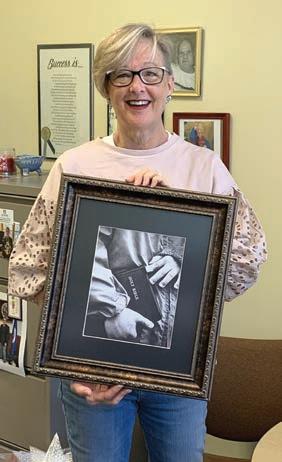
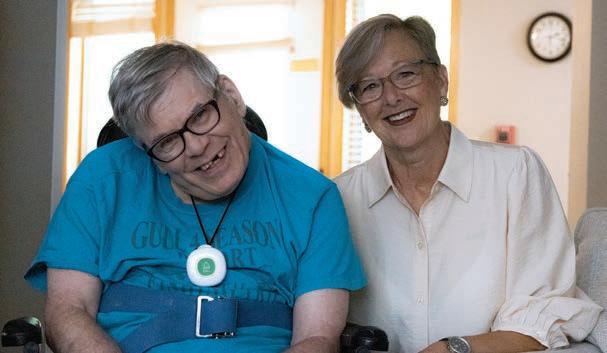

Jennifer joined Hammer Residences in 2022 as a writer and editor. Her passion is helping others tell their stories.

Up until its closing in 2019, NER’s respite program provided a short-term “home away from home” for individuals with developmental disabilities. Children and adults from more than 60 Twin Cities communities were served by the respite program located in a residential home in White Bear Lake.
NER provided a “home away from home” with its respite services.

While staying at respite, individuals could meet new friends, participate in communitybased activities, and experience life outside the family home. Having served more than 400 different people from 1981-2019 when it closed due to staffing shortages, respite was a vital service for families. Typically, people would stay once a month for two to seven days. The total break from the day-to-day care a special-needs child required was also beneficial to parents and siblings as it provided opportunities for attention and activities that might not be possible when the child with disabilities was at home. NER’s respite program helped people learn how to be away from their parents, which eased the move into a group home.
NER’s respite program was very helpful to Tiffany (third from left) and her family for many years.


Michelle Olson is a NER parent and served on the Board of Directors from 2000-2022, when she joined the Hammer & NER Board. The Olsons’ daughter, Tiffany, used the respite program. “It ended up changing our lives,” says Michelle. “Tiffany had many grand mal seizures every day and needed close supervision. We had two other young children and when Tiff went to respite, we could spend time with them and help them with their homework. I remember picking Tiff up one day from respite—she was sitting there with her peers just hanging out and having fun. She had never had that—her own life. That program was wonderful. It was so critical.”
Board member Laurie Moga (right), was a Lead Direct Support Professional for many years.
Carla Pleasants first began working at NER when it was in the St. Mary’s Church convent and later worked at the respite program. “Respite was the way many individuals entered our group homes,” Carla says. “A lot of families bonded at the respite program and found that their children fit together well, and they would move into a home together.” She has many fond memories of her time working in respite. “When you work closely with people who learn differently and their life is different, you can learn from them—they’ve enriched my life,” she says.
Laurie Moga, whose brother, Pat, was occasionally supported by the respite program, was the Lead Direct Support Professional (DSP) for many years. Laurie now serves on the Hammer & NER Board of Directors. “I loved working at respite,” Laurie says. “We got to work with a variety of people. We would get some clients every month for a week; the parents needed the break. They were so thankful for the chance to recharge and not have to worry about their child being safe. Some referred to respite as ‘camp’ to make it sound more enticing to their child.”
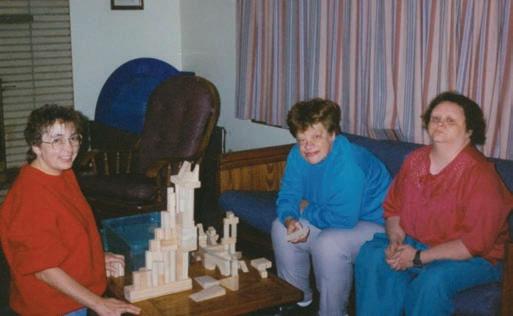
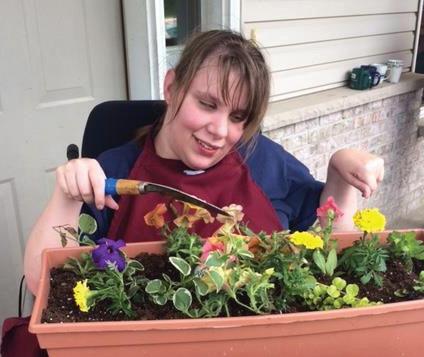
Daniel and Diane Kirchoffner formerly served on NER’s Board of Directors. Their daughter, Denise, began using the respite program when she was 9 years old. “Respite was great for Denise as it allowed her to still thrive while not at home and provided her with the love and care that she needed,” they say. “It was sad to see that program discontinue. The love, care, and a home away from home benefited everyone.”
Getting ready for Halloween!



Jan is a Lead Direct Support Professional at our 1st Avenue home in Plymouth. Throughout her career, Jan has worked at many of our homes including Carlson (when it was located on the Hammer campus), Tyler, Cedarwood, McGlinch, Garland, Jersey, and Wentworth.
I’m sure I had no idea when I went into the Hammer main building to pick up an application in January of 1990 that I would still be here 33 years later. It was to be a second job, every other weekend, that was close to my home. It didn’t take long before I became a full-time staff and never left. I did change positions, worked at different houses, and went part time on occasion but I never left. I have stayed so long because of the relationships I made here. After all these years the individuals became like family and their families became like a family to me.
Several years ago, a local news station did a story on the Hammer Thanksgiving dinner. The lead-in for it said the dinner was about the family we choose. I liked that! Because my family lives far away I have spent most of the holidays over the past 33 years at Hammer with the Hammer staff and people we support. As we age, our families age, too. Many of the people living at Hammer have lost their close family members and have nowhere to go for the holidays. It becomes up to the staff to carry on the traditions. We are their family on holidays.
As we, staff and those we support, age we have adjusted our activities and energy levels. This is good because there is no way I could do what I did 33 years ago! We have also had to adjust to the age-related physical changes that have often required adaptations to the living arrangements of the people we support. Hammer has always found ways to continue to support people as they age and need increased care. It may require a change of homes to better suit their needs, but they can continue to live surrounded by friends they have known most of their lives— people who are like family.
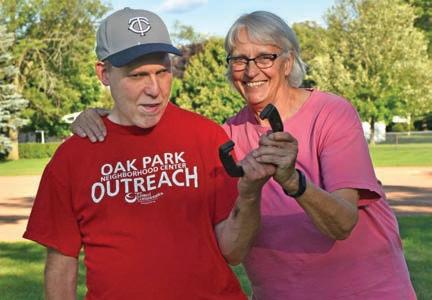
When one of the men I support lost his beloved grandmother, he decided that I would become his “grandma.” I said that was fine but not to expect the frequent gifts of cash that his grandmother sent him! Now he calls me “Grandma,” which seems to confuse healthcare workers when I bring him to medical appointments.


I’m not THAT much older than he is! But I don’t mind being called grandma. He is, after all, part of my Hammer family. The one I chose 33 years ago.


 By Wendy Paulson
By Wendy Paulson
Wendy Paulson worked at Hammer during two different chapters of her life and recounts the impact it made on her personal and professional life.


As a child, Hammer School fascinated me. In my innocence, the large, old house was mysterious and inside was a big cheerful and harmonious family. I didn’t understand why the students didn’t go to my public school, but it was clearly a special place. After my first visit in 1968, I couldn’t wait to return and I’m glad I listened to the voice inside urging me to get closer. Hammer School drew me back as a volunteer and summer staff during high school and college and then as a permanent employee weeks after I graduated college as a teacher. In the 1990s, I left for other teaching work but eventually returned in 2010, retiring in 2020. My last decade at Hammer Residences was in Human Resources. I conducted hundreds of interviews and when an applicant was a good fit, I would always tell them I looked forward to seeing what they would bring to Hammer. Later, I enjoyed seeing how Hammer changed them. As I reflect on this milestone 100th anniversary I am proud of my good work here but even more grateful for what Hammer did for me.
Hammer changed me in many beautiful ways. I discovered my Love Language is being helpful and contributing. I learned that serving and making a difference fills me up and gives me purpose. My family was able to share activities with friends who live with
disabilities and their world became richer. I worked in an environment where the motto was to “live life to the fullest.” As a result, I became more confident. I found that when an opportunity came along, I would raise my hand and not overthink the challenges. I was given interesting projects, learned new skills, and developed challenging programs. I applied for promotions and tried on different roles as Hammer adapted to remain a leader in our field.
In my career, I have watched as people I knew and cared about moved from a boarding school, to dormitories, to sheltered work, to public schools, to community homes and apartments, and competitive employment. Every door pushed open was due to family love and activism. Hammer helped shape my values about service, differentness, discrimination, inclusion, and political advocacy. I learned what is essential to supporting people and because of Hammer, I know what quality care looks like. In the last three years, my husband has survived serious illnesses and lives with physical disabilities. My decades with Hammer gave me the skills to support him and because I’ve experienced what is possible with good communication and collaboration, I have been able to create a strong team to support us.
Yes, Hammer has been blessed with thousands of dedicated employees, volunteers, and supporters over the years, but we in turn have been equally blessed by Hammer. I am grateful to have been a part of the extended family.

 By Virginia Carpenter
By Virginia Carpenter
Virginia
Carpenter
is a Direct Support Professional at our Jersey home. She first came to Hammer in the 1970s when she did a month-long internship while in high school.





In 1985, I was working at Dayton’s as a stock person and would work the floor and do sales when needed. I was having a bad day one day when Lisbeth Armstrong walked through. I believe she was Hammer’s Chief Program Officer at the time. We started talking and she told me about Hammer and encouraged me to apply. I accepted a full-time position working in the dorms, on the Afton floor. This was about two years before we began downsizing and moving into group homes.
I opened the Sumac home and was the house coordinator, which turned into a manager position a few years later. Then, I left for three-and-a-half years to do the same work over in Wales. My mother was British and married an American which brought her to Minneapolis. I have friends and family over there. One of which needed help with their autistic foster child. They asked me to come. There wasn’t anything holding me back, so I said yes.
When I came back to the US, I became a support staff at Hammer. Later, I transferred to our Lakeside home and then when Jersey was built, a team was put together of seasoned staff. I was one of them. I have been here ever since, which is about 20 years.
I had a sister with a disability who died when she was one year old. Because of her, my father joined the Board at Hammer for a few years. He was my first introduction to Hammer. What keeps me here are the relationships you develop with co-workers, the people we support, and their families. How I view this job is walking in the door and helping individuals live their lives. We live life with instead of living life for. I like to really get to know the people I’m working with and spot places that they can grow—I want them to grow to their greatest potential. I’ve said many times that I will walk through anything with them. We can learn skills together and they get more confident and become more independent. Families notice a difference and talk about the changes they see.
I have lifelong relationships through Hammer with my colleagues and the people I’ve supported through the years. I’m very thankful!

 By Jill Kunze
By Jill Kunze


Jill Kunze is the Program Manager at our Black Oaks home and joined Hammer Residences in 1982.





My first experience at Hammer was when I did my internship for college in 1982. It was on the girls’ floor of the old main building. I still work with one of the ladies who lived on the girls’ floor! After my internship, I applied for a job and was hired part-time on the women’s floor. There were two floors on either side of the old main building with about a dozen people on each floor. We did a lot of activities together—dances, Halloween parties, and Christ for People (it was AMR back then). We also walked into Wayzata quite a bit, which was just a few blocks from the main building. We would go to the Holiday gas station, Ben Franklin, and Country Kitchen. Meals were served in the main dining room—everyone would go down and eat together. It was definitely like one big family.
There was a pool behind the building that we used a lot in the summer. We had “summer staff” who worked during the day. They would hang out at the pool and do other activities with the people who were at home. There used to be a craft room in the basement with looms for making rugs and placemats. Latch hooking was also very popular.
In 1988 we started downsizing, moving everyone into houses and apartments in the community. This was really nice for the people we supported. They each had their own rooms, which wasn’t always true in the main building. The people we supported were able to learn the skills to make them more independent, including cooking, laundry, and cleaning.

When we downsized, I went to the Orleans group home in Plymouth. It has since moved and is called Zachary. The downsizing was difficult for some staff. In the main building we were used to having staff we could call to help when needed and they would come over right away. We missed the comradery. I still have friends that I met the first few years I worked at Hammer. We tried to keep the connection for the people who lived in the houses. We got together with Black Oaks and Queensland for dessert, hanging out, and having holiday parties. Because the folks had known each other for a long time we felt it was important to keep up those friendships.
Today I am the Program Manager at Black Oaks and have been here since 1992. It’s one of the first houses Hammer bought. Tyler group home is close, and we visit them. I enjoy working with the four ladies who live at Black Oaks. Diana is the only “original” from the downsizing. She is also the one who I worked with when I did my internship. We definitely go WAY back! Many years ago, when we were in the main building one of the staff had a very sporty car that Diana really liked. Diana was very observant (still is!). One day, she got the car keys and took a drive down the frontage road. Fortunately, she didn’t get hurt.
Over the years life got better for the people we serve. They are mostly treated with respect and their opportunities for jobs in the community and just being in the community has gotten so much better. People realize they are like anyone else and deserve to be respected like anyone else.

 By Mary Gaasch
By Mary Gaasch
Mary Gaasch is Director of Advocacy & Community Relations. Mary first joined Hammer Residences in 1996 as a Direct Support Professional. Mary meets with key elected officials to advocate for the people we serve and the staff who support them.
Meet Bob Lockwood, parent, Board member, and lifelong advocate for people with disabilities. Bob and his wife fought for full inclusion in the community for their two daughters, Stacy and Dru. “We were told to turn them over to the state,” says Bob. “We fought that for a long time. In fact, we fought all the way along.”
Decades before the ADA was passed, the Lockwoods worked to get their daughters the support, education, and resources they needed to live full lives. In 1985, they opened one of the first group homes in the state of Minnesota, and later joined the Northeast Residence family in 2016. Stacy passed away in 2021. Dru continues to share her rich life with her friends and staff at Hammer & NER.
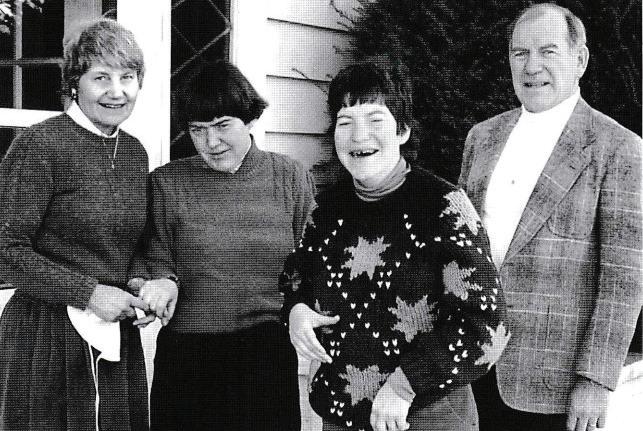
I had the opportunity to enjoy a cup of coffee with Bob and ask him for his advice for a new generation of advocates working to ensure people with disabilities have all the resources they need to live life to the fullest. At a pause in our conversation, I overheard a conversation nearby. Two young women were talking about a child’s birthday party.
“She wants to invite them and their paras from school, so they can have help if they need it,” said one. “I told her she could invite them, but the paras probably can’t come because they are not working then.” “Maybe invite the moms?” suggests the friend. “Yeah, that’s what I suggested,” said the first mom. “I told her we can help, or the

moms can help if they need extra support.”
I was deeply moved. I know in this world—where little girls imagine ways to support their friends with disabilities at their birthday parties— would not have been possible without Bob’s influence in our community and his tireless advocacy. His battle for education, inclusion, resources, housing, and staffing for people with disabilities is benefiting people with disabilities all over the state of Minnesota.
“Advocacy must be a top priority for all of us to keep getting the services we want for our loved ones,” Bob told me. “We focus on legislators—and we have to—but we need to include families, neighbors, friends, and the general public. Use social media, invite your legislators into your home, and be fully informed. Advocacy starts with me.”
Thank you, Bob. We admire your loving dedication to your daughters and your determined advocacy for all people with developmental disabilities. We are so happy you are part of our family, extended.
The Kirchoffners’ daughter, Denise, used NER’s respite program and later moved into a NER home. Daniel and Diane served on NER’s Board of Directors from 1991-1996.
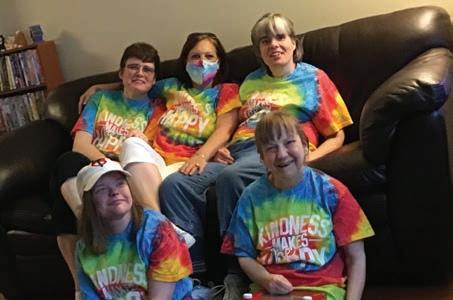
Denise started using the Northeast Residence respite program when she was 9 years old. That wonderful service to families is no longer available but it sure groomed Denise for her future needs. Using the respite program provided her with the opportunity to pack her suitcase for “sleep over” events away from home. She could still attend her school education through the #916 program at White Bear Lake schools plus the many social activities provided by NER staff. Respite care was also a stepping stone to helping her adjust to moving into her first home in Oakdale in 1994 when she was almost 20 years old. Later, everyone at Oakdale moved to the Hale home. Denise has thrived with the wonderful, caring, and respectful NER staff. Many have cared for Denise for over 20 years. She is happy at her home, that being one of the goals her parents, siblings, and extended family wish for her.
Denise loves a good conversation!
NER Raiders, shopping, eating out (she always seems to know where the nearest McDonalds is), and watching her favorite shows (Dukes of Hazzard, The Brady Bunch, and Gilligan’s Island). She really enjoys having coffee whether at home or while out and about. Denise likes talking on the phone and enjoys calling her family often. She also has a few special friends she likes to chat with on the phone.
Denise’s favorite color is purple, her bedroom is a beautiful shade of purple, and most times you see her she is wearing something with purple on it. She is extremely friendly, loves to people watch, and says hi to everyone she sees while she’s out shopping or walking around the neighborhood. Denise always seems happy no matter what she is doing. She enjoys telling her own little jokes and making people laugh. She is also happy to help with things that she can do around the house.
We are happy that our always smiling daughter is happy and that she is part of the NER family.
There are many activities Denise enjoys doing including going to dances, bowling with the



So many pumpkins to choose from!

Cathy Thoma joined Hammer Residences in 2014 and helps volunteers find just the right fit for their skills and interests.
Andrew Pollock began volunteering at Hammer Residences in 2018. He first heard about Hammer from someone he knew well who was currently volunteering at Hammer and highly recommended it. At the time, Andrew was looking for something to do outside of work, and he thought that volunteering at Hammer would be a fun opportunity. “I made the right decision,” says Andrew.
Last year, Program Manager Amelia Gesirr reached out to the Volunteer department looking for a volunteer for Josh. Josh’s volunteer had recently moved out of state for work, and he was looking for a new friend. Amelia mentioned that Josh is very social and loves to do activities, like sports, and going to the movies. He is also a very talented artist.
As it turns out, so is Andrew. When Andrew first applied to volunteer, he mentioned he enjoyed playing and watching sports (basketball, bowling, football, tennis, biking, golf), watching movies, listening to music, and drawing. Andrew and Josh seemed to have a lot in common, and so they were matched together. Success!
Ever since then, Andrew and Josh have been meeting weekly. They enjoy hanging out, going to sporting events, playing video games, and watching movies too. Amelia had this to say about their relationship, “Josh and Andrew get along very well, and Josh



enjoys Andrew’s company. Andrew is a good communicator and very interactive with Josh. They do a lot of indoor/outdoor activities together. They went to the MN State Fair last year and Josh loved it. They are looking forward to more activities this summer.”

Josh and Andrew enjoy creating art together. Andrew will draw while Josh paints. Recently, Andrew helped Josh set up his tent and display his art at the Northeast Farmers Market, where he sells his paintings. Josh is so popular that he has 10,000 followers on TikTok!
When asked what keeps him engaged, Andrew says that getting to do a lot of different activities with Josh weekly has been a great experience and has had a positive impact on him. “It gives me a great perspective and gratitude for the position I’m in and the opportunity to be involved in volunteering. I also feel like Josh and I have a great bond and I really enjoy getting to volunteer with him.”
Andrew also highly recommends that others should volunteer as friends to an individual supported at Hammer & NER because, “It has been an awesome experience for me and would be for others as well!”
Thank you, Andrew, for making it an awesome experience for Josh, too!
Barb Tuckner is a former Hammer Board member and was Board president at the time of our former CEO Tim Nelson’s untimely passing. Her father, Jerry, also served on Hammer’s Board of Directors. Barb’s cousins (who own Warners’ Stellian Appliance) have been long-time supporters of Reach for Ralph in honor of Barb’s sister, Janet, who has been supported by Hammer since 1981.
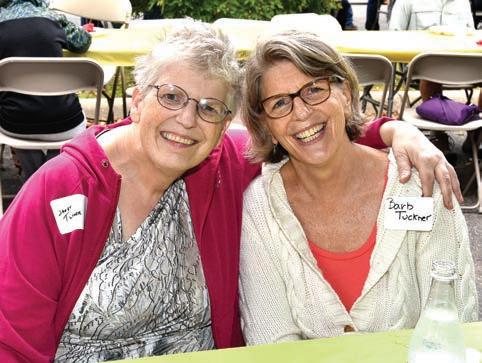
When Tim Nelson, previous CEO of Hammer Residences, eulogized my father in 2009 he said that “While it has not been completely verified, Jerry Tuckner was the longest serving Board and committee member in the history of Hammer.” He went on to talk of my father’s dedication to Hammer and his service ethic. At the time, I was serving on the Hammer Board and thought at that moment I was in some way standing adjacent to my father’s legacy. That was enormously comforting on that sad day. I was so grateful to Tim for echoing that message off the church walls—walls that my father, incidentally, had a part in building as well. I remember sitting up a wee straighter in the pew and feeling even more proud of my dad.
I suspect most of us have been tapped for service in any number of situations. Who hasn’t watched a child for at least a moment while a parent tended to a task or, shoveled a walk for someone or, held a door for someone struggling with crutches? At Hammer & NER, you may have set up tables for the Family Day Picnic or the Luau, greeted people as they arrived at the Reach for Ralph fundraiser, or raked the yard of one of the group homes. All these acts are critical and demonstrate a service ethic and commitment to giving back to the providers that have helped make a safe and comfortable home for that person in our lives who has
special needs. All these acts serve to further define us and build our individual legacies that Hammer & NER can stand on forever. We’ve often been told that we are needed. Our hands can join together in service that sustains and reaches everyone supported or working for Hammer & NER. It is breathtaking, really.
I have a set of simple rules I follow when I engage with Hammer & NER:
• Pay attention to what my loved one’s house or apartment needs and help to get it.
• Show gratitude to every DSP, house manager, office staff, etc., that I encounter.

• Show up with my talent and/or my muscles that are still in good working order.
• Know my legislators and make sure they know me and my loved one.
• Give a budgeted amount of money continuously to Hammer & NER to demonstrate my ongoing support.


I am indebted to Hammer & NER and all its past and present leaders for their business sense, passion for the people they support, and the talent they recruit to help build a loving and caring home for my sister. I will continue to show up where I can and as a side benefit, hope to build a small legacy as an homage to my father, my sister, and that intrepid soul, Tim Nelson.


 By Cathy Thoma, Director of Volunteer Resources
By Cathy Thoma, Director of Volunteer Resources
Hammer & NER has been so fortunate to have had a variety of Community Partners over the years. These are individuals and organizations that have been committed to supporting our mission and making both a financial and personal impact on those who call Hammer & NER home.
One such special organization is Medica. In 2012, Medica partnered with Hammer to provide Care Coordination for 300 of Medica’s Special Needs Basic Care Program members. Part of their mission was to get to know the people they served through this program. They began by volunteering at our Fall Yard Clean Up event. Medica employees enjoyed their experience so much that they asked to volunteer on a continual basis. That’s when Medica adopted our Hammer Day Support Program.
Renee Farrow led the first Medica team that came every other month to help our staff with a day of fun and community engagement. This became so popular that a second group of Medica employees, led by Sabrinna Berghorst, also began to volunteer. With the extra hands and hearts helping, everyone got to enjoy bowling outings, pizza and holiday parties, cookie baking, board games, and visits to the zoo!
In 2019, Medica was recognized for their volunteerism with Hammer by receiving the Game Changer Award from the Corporate Volunteerism Council – Twin Cities. They received $1,000 and promptly gave the check to Hammer. It didn’t start there, however. In 2014, Medica granted Hammer $30,000 to begin our Healthy Living Initiative which is known today as our thriving Community Life department. Since 2019 they have contributed $21,000 to several projects related to the health of those we support. They have been incredible partners, giving $51,000 in total since we began the relationship 11 years ago. In recognition of all that they have done for Hammer & NER, Medica received our Community Partner Award in 2020.
When COVID-19 forced us to shut down our Day Support Program, Medica still found a way to offer support by donating over 10,000 masks for our staff and individuals to use. While the Medica volunteers couldn’t see their Hammer friends in person, they were able to use Facetime to stay in touch, cheer people up, and celebrate birthdays!
In 2022, Hammer & NER began the Cooks in the Kitchen program. Medica was one of the first organizations to raise their hand to participate in cooking meals for our homes


that were short-staffed. To date Medica groups have volunteered in our Cooks in the Kitchen program 10 times, making 80 meals each time, adding up to 800 meals!
“The Medica Utilization Management team loves volunteering at Hammer because it impacts the people in our own community,” says Sabrinna Berghorst, Supervisor, Utilization Management Operations - Health Services at Medica. “We like knowing our neighbors are getting a warm meal. Cooks in the Kitchen hits close to home with one of the team members who has a nephew with Down syndrome. Knowing someday he may be helped by an organization like Hammer & NER makes her feel good, that in this small way, we are making a difference to those who care for the residents of the homes. We love Hammer!”
Medica’s partnership has had such a great impact on the individuals supported by Hammer & NER. Their volunteer efforts have allowed individuals to participate in community activities, elevating their spirits. Their financial support has secured health initiatives, including our Community Life program.


Volunteers helping during Fall Yard Clean Up to beautify homes and making delicious meals makes everyone content and happy!

We look forward to our continued partnership with Medica as we begin our second century of service. Thank you, Medica!


Ellen is Chief Development Officer and began working at Hammer Residences in 1982 as a Counselor. Forty years later, Ellen builds relationships by sharing the needs and heroic stories of the people we serve and of the incredible caregivers who support them.
William F. BieberJune 3, 1942 – April 7, 2023




The legacy of Bill Bieber is one marked by philanthropy, service, and giving back to his community. We were fortunate to be a recipient of all three. Bill had a profound impact as a friend, visionary, and leader. His transformational efforts have made Hammer the best place possible for his son, Jimmy, and everyone we support.
In the early 1990s, Bill and a handful of Board members took a special interest in the individuals living at Hammer. They saw that some had very little and that their personal philanthropy could help. With Bill’s leadership, they set out to provide basic needs for those who could not afford medical care, a new coat, or even a night out to the movies, and created Hammer’s Quality of Life Fund.
Bill’s motivation was influenced by his family’s experience when they moved Jimmy to Hammer in 1991. With a young family, Bill and Kathy knew that Jimmy needed more. They found the support from caregivers in his Hammer group home was crucial to his life and theirs. Bill motivated others when he shared his story and the difficulty raising Jimmy at home. To him, Hammer “saved our lives.”
With infinite gratitude and a deep passion to give, Bill introduced friends and colleagues to Hammer’s mission. Over the last 33 years, his friends have understood the dedication behind his mission, and together they have contributed more than two million dollars to the Quality of Life Fund. Hundreds of people living with disabilities have
experienced a greater quality of life even when they didn’t have enough to fully support themselves.
We are greatly saddened by Bill’s passing in April. However, his legacy will live on. Day after day, and year after year we will continue to see his impact on the lives of those supported. For 80 years, Bill led with his passions and enduring life story. His legacy will live and grow — especially among his friends at Hammer.
Here are some thoughts about Bill from people who knew him well.
Bill was first and foremost a family man. He was also a wonderful friend and took that role very seriously. Bill was always the one who would be reaching out to friends. Everyone took him up on his invitation because he was such a positive, fun guy. Most importantly he was a man of faith who lived and shared his faith in words and deeds. Bill built successful businesses and he used that success to help nonprofits. One of the greatest stories about Bill and Hammer is when he sold a business and one of the conditions of the sale would be for the new owner to make almost a seven-figure gift to build Hammer’s new headquarters in 2000. He loved that he was able to secure that gift to his greatest charity. He loved Hammer for how well they cared for Jim and his friends. —Mike Sime, longtime friend
There are a rare few who have impacted Hammer like Bill Bieber. —Ward Brehm, lifelong friend, businessman, author, and global humanitarian
I considered Bill to be a mentor and friend. I knew he had the mind of a savvy businessman, plus he had the utmost desire to see Hammer be the best. His friendship, expertise, and no-nonsense replies will be greatly missed. —John Estrem, CEO, Hammer & NER
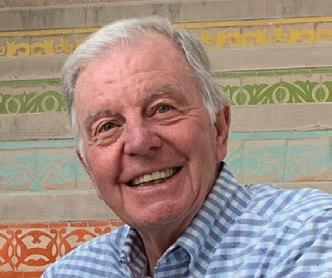
Tom and Lee Ann’s son, Jeff, is supported at our 13th Avenue home in Plymouth. The Silvers are long-time generous supporters. Tom served on the Hammer Board and Lee Ann has been a valued volunteer for many years.
In 1985, I started my involvement with Hammer Residences by answering the call for drivers to bring people from the Hammer dorms in Wayzata to worship at Holy Name of Jesus. We’d pull up in our cars, six or seven of us, and drive 20 or so people over to the church. When Hammer moved into group homes, we’d have a route we’d follow to pick up people. Our pastor at the time, Father Arnold Weber, had just started a “special needs” ministry with worship, faith sharing, and Bible studies. Parishioners were so welcoming! People from Hammer like Don Rudd and Jim Finney and so many others became some of the most faithful, beloved, and vocal participants in the Mass. I will never forget whenever Fr. Arnold said something that he agreed with, Jim would always say, “That’s right!”
In 1987, my wife, Lee Ann, gave birth to our son, Jeff, who has Down syndrome. Lee Ann was a nurse, and I was involved with Hammer, so we knew a bit about what was ahead of us. When he became a teenager, Jeff started talking about living in a group home like the people we were driving to church. Fast forward to 2023, and now Jeff lives at the 13th Avenue home in Plymouth. He loves living with his housemates and staff and it is our hope that Jeff will remain with Hammer for the rest of his life.
In 2013, Tom Silver, Bill Young, and Joe Reis, Hammer Board members and Holy Name parishioners, sent a letter to friends requesting donations to Hammer to maintain its high standard of care. Since then, those who received that letter have gone on to contribute almost $260,000.
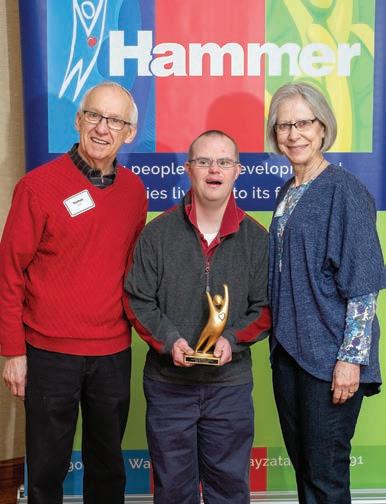





Tom and Mari Lowe connected with Hammer when Mari started bringing her therapy dogs to visit our homes. They saw the great work that was happening for people with disabilities. But, when they realized that many of the people we support went without Christmas gifts, it became their mission to provide something for everyone each holiday season.
When Tom and Mari started their holiday tradition, Hammer served 46 people. Today Hammer & NER serves 362 people across the metro. As we grew, so did Tom and Mari’s generosity: everyone who needed a little something extra at the holidays got it—gifts to share with family, holiday merriment to enjoy with friends, or a trip to Duluth to see the lights of Bentleyville filled the holidays for hundreds of people who otherwise would have had a “Scrooge” kind of holiday.
So, each year for over 40 years, Tom and Mari quietly opened their holiday hearts. In return, they delighted in the handwritten and artfully crafted thank you notes they received from individuals who had a brighter holiday because of them. “Each year we looked forward to seeing these cards,” they told us.
We believe in the magic of Tom and Mari Lowe, our holiday angels. (Mari passed away in 2022.)
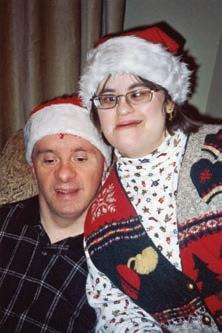 Tom, Jeff, and Lee Ann Silver at a Spring Breakfast.
Tom, Jeff, and Lee Ann Silver at a Spring Breakfast.
 By Lin Curran, Chief of Operations
By Lin Curran, Chief of Operations
Over the years, NER has participated in a variety of community events (and hosted a few of our own!) that help to connect the people we support with their community. We’ve also helped them explore the world through exciting travel opportunities.


We began holding this event in 2017 and wanted it to be a fundraiser, but we didn’t make a lot of money. The Walk Run Roll was held at Lake Phalen the first year. After the first year, it was an event for the people we supported and held at the Oakdale Nature Preserve. There was a short route and 5K route. It was a fun way to gather everyone together and we’d enjoy pizza afterward.

When this started in the early 1990s, we had everyone from the long-term ICF come to my family’s house for a bonfire in the fall. Mark Kain (direct support staff) and Dusty Anderson, our maintenance person, were in a band together and they would entertain us. Gradually, it got too big to accommodate everyone, so the Arcade home in Maplewood began hosting a Halloween bonfire. We would all bring a dish to share and come in costume. Later, this became the Halloween Extravaganza, and we moved it to the NER offices (no longer a bonfire) and did that up until COVID-19. Then it became Trunk or Treat.
Back in the late 1980s, a group of us would get together at our ICF home (at the convent) and fill 3,700 balloons with water—about
74 buckets’ worth. We got a moving truck to haul them to the event and then we would sell them, and people would lob them at the racers on the obstacle course. Later, when we moved out of the convent, we went to the 5th Street home to do the balloon “prep.” The people we supported could participate and many of the staff enjoyed helping and dressed up in costumes. One year, our Addams Family team won for best costumes!
In 2006, we took a group to an allinclusive resort in Playa del Carmen (six people supported and five staff). This was the first time we were able to take people out of the country. We were so impressed by how gracious the people were. The wait staff were so good about helping us and the community really welcomed us. We visited the Mayan ruins which were incredible. We have also taken trips to Hawaii, Branson, Washington, D.C., Disney World, Jellystone, and the Kingdom of Tonga to name a few. We’ve enjoyed all our adventures and are so thankful to the staff and volunteers who made it a reality for the people we support.
Whether it’s enjoying a bonfire in the backyard, engaging with our local community, or traveling to new places, NER has always valued creating opportunities to build the self-confidence and social connections of the people we support. It makes life all the richer and sweeter.

 By Kathy Jolly
By Kathy Jolly
Kathy Jolly retired in 2000 after working as a Direct Support Professional and in a supervisory role at NER for 20 years.
I joined NER in 1980 and worked at two of our group homes until retiring in 2000. The residents were part of my family. My children grew up with the nine residents in house #1 (NER’s first group home) and they also came over to our house many times to visit and celebrate holidays and birthdays. Many times, my own family suffered, because I was taking care of my extended family. My kids and husband would stop by house #1 in the evening or on the weekends to play with the residents and spend time with them.
My kids enjoyed playing ball with Dan, swinging on the glider with Ann, walking alongside Ken when he was in the parking lot on the three-wheel bike, or just playing games. We would have picnics at the house and holiday celebrations and my family would join us. When I first started, we worked 14hour shifts on the weekend. If the weather was good, we would go on a road trip for the day, stopping at a state park to have a picnic lunch. Some people would relax, some would go for a short hike. If there was a lake, Dan and a staff member would fish. One time, three of us staff took a group up to Camp Du Nord in Ely for a long weekend in the fall. We stayed in a cabin that was not heated. It was cold and rainy all but one day—the day we needed to leave. During this trip Dan and one of the staff fished, and we went for canoe rides, short hikes, and into Ely to warm up!

Toward the end of my career, I took the residents to all their medical appointments and emergency room visits. Several of them had a fear of the medical community, and it was so hard for them to understand they were just trying to help them feel better.

There are so many people who impacted our lives as direct support staff. Just a few include Lenore and Verline, our cooks for many years. Bea, Lucy, and Maria were our housekeepers and Lester and Bill were our maintenance staff. Ann and Jim were the live-in staff. There were also instrumental people at St. Mary’s who were very involved with putting on holiday parties and supporting us in so many ways. It meant a lot to the residents and staff to have them as part of our family. St. Mary’s School would let us use the gym during the winter months which gave our residents a place to play when it was so cold out.
I know the memories that we created together will be with me forever. My kids still remember spending time at NER. I’m blessed to have been a part of NER and the impact the residents made on my life is unimaginable. My love for the people I supported kept me there and I truly cared for each and every one of them.
 By Lin Curran, Chief of Operations
By Lin Curran, Chief of Operations
There are many organizations and individuals who have supported Northeast Residence over the years by generously giving of their time, talents, and financial gifts. There were groups like the Lions Club, American Legion, VFW, and Rotary Club whose incredible financial and material support was vital when we first opened NER in a former convent in White Bear Lake in 1973. St. Mary’s Church provided the space, rent-free for the first three months and the ladies of St. Mary’s hosted a “shower” to collect items for furnishing the rooms. High school students measured the rooms for paint, carpeting, and curtains, and local business and civic organizations, neighborhood groups, and individuals provided materials and labor. The Lions Club donated NER’s first van. Other community churches and organizations gave to the new home as well. By the time they were finished, all the rooms had been completely furnished. Best of all, the new organization didn’t spend a dime! Truly amazing.
As the need to expand our services grew, we began purchasing homes in residential settings in the 1990s for our first group homes. We also added extended day programs and a respite program. The community generously contributed to our fundraising efforts, including corporations, foundations, civic organizations, and individuals. Over the last several years, groups such as the Rotary Club helped with smaller projects in some of the White Bear Lake homes; the Eagles Club spruced up a few yards; and Donatelli’s has been a long-time friend helping select the Ken and Marion Owens Scholarship recipients each year. (The scholarships are awarded to NER employees to further their education.)
For several years, the Knights of Columbus sponsored a Tootsie Roll Drive. This was a fun partnership that the people we support could participate in. It took place the last weekend of April. The Knights of Columbus would set up tables outside of Cub, Kowalski’s, or Sam’s Club and provided the Tootsie Rolls. We provided the people. We earned about $12,000 in three days. We stopped doing this during COVID-19.
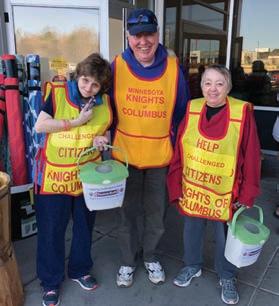
These are just a few of the local groups who have helped NER along the way. We are forever grateful for all the love and support our local communities have shown us over the last 50 years. Each of you is an integral part of helping those we support live life to the fullest.
The Cup and Cone in White Bear Lake is owned by the Johnstone family and is a “sweet” friend of the people we support. For years they have provided a complimentary ice-cream cone to the people we support who drop by. Keith Johnstone, the second-generation owner, served on the NER Board from 1991-1996.
“It brought more smiles to me,” Keith says of offering people a complimentary ice cream cone. “It was nice to see people from NER come up and order and even want to pay sometimes. When they came up to the window to receive a cone, it brought a smile to my face.” Although Keith is retired now, his son, Rick, took over the business and maintains their tradition. “It’s something nice we can do for people at NER,” Keith says.

Sondra Hampton is the Operations Development Manager for Northeast Residence and joined the organization in 1995 as a Direct Support Professional.

On my first day on the job, I got punched in the face.
I quickly learned that “behaviors” are actions that communicate. I told my sister, who I was working with, that I was done and that it wasn’t worth the $6.75 an hour. However, 28 years later, here I am and loving what we are doing for the people we support.
As a DSP, I never thought the little things I did each day would make such an impact on other people’s lives. The routine and stability that we provide is so important, it creates trust and builds relationships. I remember one morning when I was working at the Hale house, Denise called me “Fred” and I said, “Why am I Fred?” Her immediate response was because she was Barnie, and we were best friends (like the Flintstones cartoon).


I really enjoyed working in the homes with the people we support. In 2005, my son, Corey, had his first grand mal seizure and at 22 years old he continues to have them. If it wasn’t for the parents of the people we support that I’ve gotten to know over the years, I don’t believe I would have known how to advocate for him, and without my experiences as a DSP I don’t know how my family would have survived the daily challenges that someone with special needs brings to the home. Living the daily struggles makes me so appreciative that there are places like Hammer & NER for the people we support and their families.
As DSPs we often refer to ourselves as coaches or teachers. I have learned so many great values from people that I have worked with over the years that I think I was often the student, and they were the teachers. The thing I have learned the most is the importance of dignity. Dignity goes so far; it is simple and creates lifelong relationships.
 By Sondra Hampton
By Sondra Hampton
Mary Anne came to NER in 1997 from Pine City where she lived with her mom. Mary Anne was raised on a farm and staff quickly learned that meant waking up early. If you were the overnight staff, you would often wake up with the sense of someone watching over you. Yes, this was Mary Anne who would wait patiently until 6 a.m. to wake you up. Who knows how long she waited in her room. Mary Anne really knows how to make early mornings not so painful. She always has a smile, positive attitude, and something nice to say about you.
Mary Anne loves visitors and makes them feel welcome by offering a pop to everyone who comes to her house. She also loves staying busy in the community by going shopping, out to eat, and on nature walks. You would be amazed by how many birds she can identify. I often wondered if she was just saying any type of bird to see if I would know if she was correct or not.
At home Mary Anne likes to watch TV and the birds outside her window along with doing crafts and Etch-aSketch. I have never seen someone be able to write their name on an Etch-a-Sketch as well as Mary Anne. It is rather impressive if she is willing to show you. However, if she sees you trying to look, she will often shake it to erase the artwork.
Mary Anne is a great friend and has taught me to always be positive. If you ever need an uplift, go visit Mary Anne— you will get a smile, a pop, and probably a, “You’re so beautiful” or “You’re nice.”
 By Linda Holmen
By Linda Holmen
Linda Holmen’s sister, Anne Baily, is supported by Hammer. Linda has served on the Hammer Board of Directors, on numerous committees, and is active in many aspects of our work.


August 18, 1972, was a very important day in the lives of my sister, Anne, and our family. That was the day, 51 years ago, that Anne moved into Hammer Residences. At that time, Hammer was located on a single campus in Wayzata with a large dormitory. Anne moved into one of the rooms on the women’s floor in the dormitory and began her life as part of the Hammer family.
where life would take her; she had few prospects of living a happy and productive life and she needed guidance and social and life skills training that Hammer was ready to give her.
Prior to Anne moving to Hammer, our family had made the difficult decision that Anne needed a place to live that could offer her more training, opportunities, and a better quality of life than we could at home. Trying to find that place was not easy. Anne had already endured several years of living in very difficult situations both in local hospitals and state schools. We were told about Hammer during one of her hospital stays and jumped at the chance to move her there as it sounded like the perfect solution.
Anne (in red jacket, second row right) with her Carlson apartment friends and staff on a camping trip in the 1980s.
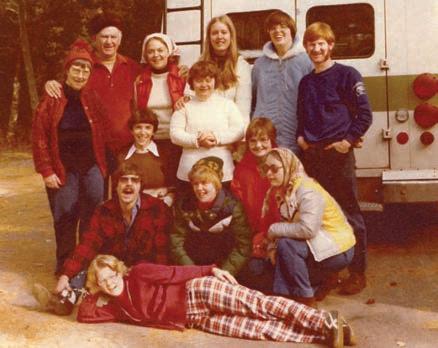
It turned out to be more than the perfect solution. Hammer was and is the best thing that could have happened to Anne and to our family. Anne was at a stage in her life where she was unsure of
Anne lived in the dormitory for some time and then began to move into new living situations as she became more and more capable of living semiindependently. She started in the Carlson apartments (which were part of the Carlson house on the Hammer campus) first, and, after several moves, now lives in the Stone Creek apartments with the support of Hammer staff. Anne lives a busy, happy, and fulfilled life. She loves living at Hammer, has many good friends there, and participates in as many activities as she can. Anne also has a job at General Mills that she loves. She has become an amazing adult with far more skills, abilities, and knowledge than we once thought possible. We have Hammer to thank for that.
The theme for Hammer’s 100th anniversary is, “Opening Doors and Unlocking Possibilities.” Anne’s life at Hammer is a wonderful example of that. Many doors have been opened and possibilities unlocked for her that would never have happened without the work of the caring staff at Hammer. We are so grateful for all that Hammer has done for Anne and look forward to her continuing to be part of the Hammer family for many years to come.
Ken Harper is the Program Director of our Broadway, Ives, Kentucky, Cedarwood, Welcome Place, McGlinch, Arkansas, Emery, and Merrimac homes. He has worked with Hammer for 32 years.
I came to Hammer in 1991, after moving here from Louisiana. I had been working in chemical dependency and wanted to get a job at Hazelden (drug and alcohol rehab center). But then I saw a want ad in the newspaper for a DSP role at Hammer. I applied and got hired. After working at Hammer’s Dublin home (now called Emery) for a few months, I knew this was where I wanted to be.

Three guys had moved into the Dublin home from a treatment center and three from their family homes. It was a totally different experience for me than working in the chemical dependency field. The thing that really got me—I would take people to the mall or to a Twins game and the whole way back they would say, “thank you, thank you, thank you.” They thanked me for doing something we take for granted. That made a huge impact on me. Later, the guys from our Dublin home and I moved to our Ridgeview home. I was a DSP and then Assistant Program Manager for 15 years. Tom Gillespie was a big mentor for me. When I became a Program Manager, he was my Program Director until he became Chief Program Officer. It seemed to be a perfect fit; we had the same kind of personality. I always appreciated that I could reach out to him. Whenever I had something new like running a program plan, he would give me an opportunity to give it a shot first and then send it to him for his feedback.
What’s kept me here for 32 years? It’s the relationships I’ve built with the people we support and their families. Aaron moved to Arrowood when he was 13 years old. It was really tough for his parents; 13 is young, but it just wasn’t working out for him at home because of behavioral challenges, it wasn’t safe for him. Now he’s living at our Hampshire home and doing remarkably well. He invited me to his bar mitzvah last year. Seeing him up there, speaking in Hebrew, he was amazing, and it made me emotional. He had worked with the rabbi for months. The ceremony was about 45 minutes long. That’s a long time for Aaron. His favorite phrase is, “That’s too long can we be done now?” You take him to the movies and he’s ready to go after the previews. But he didn’t say it once. Aaron has made such a transformation from when he moved to Arrowood at 13 to the man he is now. Maybe it’s the stability he’s had. I’m glad I was a part of it. But most of it was Aaron.


The people we support have certain challenges but they’re not different from us. I’ve built relationships with the people I’ve supported and treat them like I would my friends.
Joining Hammer has been the best decision of my career.

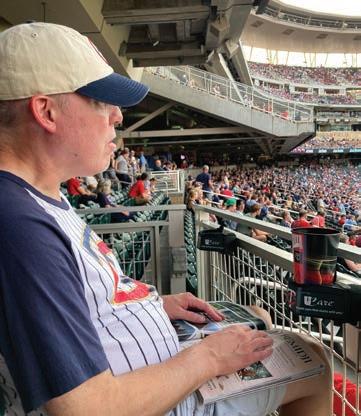 By Angela Bernhardt, Director of Major Gifts
By Angela Bernhardt, Director of Major Gifts




Pat Henry has lived at Hammer since 1975, when he arrived as an 11-year-old full of endless energy and curiosity. From living in the Winslow boys’ dorm to now living in the 1st Avenue group home, Pat has been supported by caring individuals who are drawn to his love of art and puzzles, playing games on his iPad, celebrating holidays, watching Minnesota Twins games, and keeping things clean at the house. He also loves to look at cooking magazines and cookbooks and helps to cook dinner, especially browning the hamburger because the staff do NOT do it right. According to Pat, “You don’t push it down!” When hamburger needs browning, step aside because Pat WILL take over.
At the end of his day, Pat always waits up for the overnight staff to arrive, helping them set up their bed for the night, making sure the curtains are drawn, and all the dishes are put away. This level of caring reflects the lifetime of caring he has received from those at Hammer.
Throughout his life, Pat has had opportunities to explore his own interests. Looking at old photos, Pat is always in the center of activity, eager to participate and be part of the community. Just mention you will be going out and he has his coat and hat on in a flash and waits by the door.
Pat is an includer, inviting others in, and freely expressing his happiness and joy of others, often saying, “I like him, I do!” followed by his infectious laugh. It is obvious to all who meet Pat that he is first and foremost, happy.
I’ve known Pat for 33 years and been his direct care staff for 10 years. We’ve grown old together! As he has gotten older, his physical care needs have increased, and that’s okay because that’s life. We’ve made changes to the house to meet his changing needs and as a care team we monitor a few more things. We still get out and about, everyone looks forward to events written on the big kitchen calendar, we all just walk a bit slower.


Pat’s happy life is made possible by so many people, from his family who entrusted him to Hammer almost 50 years ago, to the Hammer staff who have cared for him as he has gone through all stages of life, to the nursing team who monitor and manage his complex medical issues, and to the financial supporters who have believed in him and provided the resources necessary to ensure he lives a quality life.

“I like him, I do!”Pat Henry (right) and a Hammer friend visit the Wayzata Fire Department. Pat Henry enjoying a recent Twins game.



 By Nan Wrich
By Nan Wrich
Nan Wrich began working at Northeast Residence in 1989. Today she works as a Direct Support Professional at our 36th Street home in Oakdale.
I began my NER career when we were in the old St. Mary’s convent, in White Bear Lake. When the convent was sold, we moved to what we called house #1 and I stayed for a while before I left to work with others who had disabilities, including traumatic brain injuries. I then came back to NER, and I have been here for 34 years now. I’m currently at the 36th Street home. We have four ladies we support here. Joyce has been here the entire time I have. She has many interests and is known for her vivid personality. She used to love saving pop tops that she would then bring to McDonald’s in exchange for vouchers to get books at Goodwill. She and I would pick out books and I would read to her. Joyce and another one of the ladies and I would go to Saints North to go roller skating. I remember Joyce laughing so hard when she fell, which didn’t happen very often because she skated around hugging the wall. Joyce loves baseball (Minnesota Twins!), the Minnesota Gophers, and the Minnesota Vikings. Joyce used to play t-ball, but as she has grown older, she has lost interest in playing.




I have enjoyed spending many hours with Joyce doing puzzles, gardening in the backyard, going on walks, and hearing about the fun she had at the Twins game. She has a very dry wit. Her favorite thing to say is, “What do you want me to do, stand on my head like a monkey?” Joyce has always enjoyed going to NER’s annual Luau. She dances, and dances, and sings. When it comes to the holidays, since Joyce doesn’t have any family alive anymore, I bring her to my house. Joyce is just like a family member to me.
Joyce recently celebrated 45 years of employment with MSS. What an incredible milestone. Joyce has also done a lot of traveling and loves studying and reading about other countries. As I write this, Joyce is just getting home from a trip to Las Vegas with Hammer Travel. I can’t wait to talk with her about her adventure. I really enjoy seeing the people we support so happy.
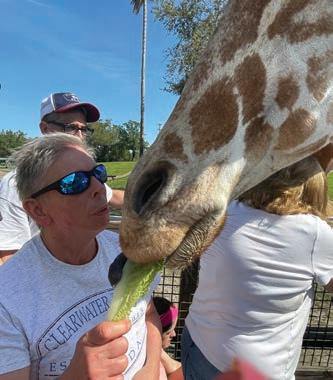
Since 2009, Hammer Travel has supported over 2,000 people as they fulfilled their travel goals. Going hand in hand with Hammer’s mission, Hammer Travel promotes personal growth, social inclusion, independence, and self-confidence, through the joys of travel. Whether visiting a new city or cruising Alaska, travel is a worldexpanding experience that plays an important role in one’s quality of life. Here are a few thoughts from travelers, staff, and volunteers about their Hammer Travel experiences.
Angeles, Branson, and Disney Halloween Magic at Disney World. I love seeing new places, and it’s fun to meet people from other states and make friends with them. My favorite trip so far was “All Things Hershey” to Hershey, PA. We visited Hershey Park, went on rides, and learned about the history of Hershey. I also like going to Wisconsin Dells. I just enjoy myself.
Malik Mohamud, Trip Leader, Hammer & NER Program Manager —

— I’m happy to share a part in making travel dreams come true for the people we support. Everyone deserves to have the opportunity to travel, and if someone needs a little extra help to be safe and supported, that’s what we’re here for. I really enjoy seeing our travelers embrace all the new things that can be a part of traveling. Sometimes it’s navigating through nerves with airport security, trying a new food, or walking slowly together into the water to touch a dolphin. I enjoy working through challenges as they arise and having a ton of fun along the way.

Joe, Traveler, Hammer’s Stone Creek Apartments — I’ve traveled a lot with Hammer Travel. I’ve been to New York, Las Vegas, Los
Witnessing the joy and excitement on travelers’ faces is truly aweinspiring. We celebrated a lady’s birthday during a late-night luau in Hawaii. For her, it was an extraordinary experience to mark her special day in a place she had never imagined visiting. Individuals can accomplish goals they never thought possible. One traveler had a deep connection to Pearl Harbor, passed down through family
Having lots of fun at All Things Hershey, 2022.
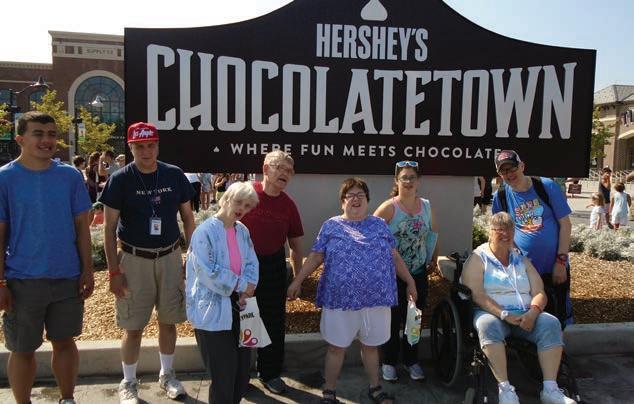
stories. His dream was to be part of the Pearl Harbor experience during our Hawaii trip. His excitement was palpable as he eagerly took pictures and immersed himself in the history that had captivated him for so long.




Pam Whitcomb, Volunteer — I enjoy providing a safe space for people to freely expand their comfort zones and experience new adventures. On one trip, an Alaskan cruise, one of the travelers with a progressive muscle disease wanted to just swim in the hot tub. The pool staff operated the lift, and we got him in the tub and a few of us went in with him. He was happy as a clam! There are always challenges, but it really helps to have a good team of staff and volunteers that work together on the difficult issues. That can turn a tough situation into a good one!
Cindi Laurent, Volunteer — I really enjoy the people I meet and the things we do. My favorite trip was swimming with the dolphins. We had a gal with pretty serious physical issues (wheelchair bound) and we weren’t sure how we were going to work out her swim. The trainers at Discovery Cove were amazing. One of them wrapped her around the dolphin and then wrapped himself around her so she could experience the swim. We all had tears in our eyes at the joy on her face.
JenniLee Wilson, Caregiver, Coordinator-MSCC, Inc, Olsonville (Carlton, MN) — We had a client who wanted to see a WWE (professional wrestling) show and I had no idea where to go about making it happen until a guardian suggested Hammer Travel. The four trips we’ve been a part of have been some of the most well planned, relaxing, and fun the clients I serve have had. We took one of the people we support to Louisiana. It’s been great to see how independent he has become after the trip. He’s really stepping up to the plate to do big things on his own.







 By Becky Bollinger
By Becky Bollinger
Becky began working at NER in 2001 and today is the Program Compliance Manager for Quality Assurance for our east metro homes. Her aunt Mary Anne (featured on page 43) resides at our Hale home.
Hollie and Kelly got to know Northeast Residence while they used respite services. When Northeast Residence decided to open their first waivered site, Hollie and Kelly’s parents jumped at the chance. As this was a new program for NER, it took a little longer than expected to get the details settled, but in September 1994, Hollie and Kelly moved into the Rollingview home on the same day. They have been together ever since!
Hollie is the fashionista of the house- she’s usually the best dressed of everyone (including the staff) and accessorizes with an impressive array of necklaces, earrings, and sunglasses. She also loves listening to music—one of her favorite ways to bond with new staff—and watching YouTube videos. Just before the pandemic, her favorite videos were of new piglets and their mothers. That August, she and Kelly went with staff to the State Fair and not only got to see some piglets and mothers, but got to pet some as well! The piglets’ owners loved her enthusiasm and answered all her questions.
Kelly’s mom was a dance instructor and Kelly spent a lot of time at the dance studio growing up. She still has a number of videos of recitals that she loves to watch. If you watch carefully, you can see Kelly in some of them! They started out as VHS tapes, but over the years her family has helped convert them to DVDs so that Kelly can watch them on “modern” players. If she’s not watching dance videos, her favorite movies are ones with catchy tunes, whether it’s musicals or Disney movies. When she’s at home, she can often be found watching a movie on her portable DVD player while she puts together a puzzle. Staff will always make sure that the picture is available to Kelly, however she usually puts them together by the shape of the piece versus the colors of the picture. Kelly is very soft spoken, but her sense of humor often has staff sharing the latest zinger, whether it’s asking out of the blue if they have paid their mortgage or renaming the staff. One of the staff has at least five names, according to Kelly, including Nora, Laura, Michelle, Dr. Frank, and Teacher (her actual name is Emily).
Over the years, Hollie and Kelly have often shared favorite activities, such as going to the State Fair. In addition to stopping to see Hollie’s piglets, they must swing through the horse barn (Kelly’s favorite), find a Pronto Pup for Hollie, and visit the one stand that sells Pepsi for Kelly! While they aren’t fans of the crowds or noise, they look forward to it each year!


Sue Gregor started her Hammer journey offering her creativity as a retired art teacher. She has become a trusted advisor, financial supporter, and friend.





As a young child, I was interested in color and shapes, making different colored water in test tubes, and designing houses to paint the walls all the different colors. That fascination has followed me throughout my life and connected me to Hammer and so many people who have become my lifelong friends.





I became an art teacher and taught many students with special needs. I was especially touched by the joy, the frustration, and the sense of accomplishment they felt. Many of these same students were later served by Hammer. This opened doors and unlocked possibilities for me.
Enter the next stop along my journey: The Hammer Annual Spring Breakfast was being held at my church, so I volunteered to help. I listened to the stories being shared and knew this was where I needed to be. Shortly after that, I was asked to help frame artwork created by Hammer artists— this was the start of my longtime work with Hammer.
I held art nights once a month and really got to know several artists well and began working with many of them in their homes. It was truly a joyful time for us, and I saw what I always knew . . . art is a universal language that has no barriers. Artistic expression is such a valuable, healthy part of our lives. I came to see this firsthand when Sarah and I put together a one-woman art show at the Hammer Central Office. Sarah was so excited when the Sun Sailor newspaper showed up to interview her. She revealed that she often felt stress and creating art helped her to relax and feel happy. I knew then that I was making a difference in her life. There is no better feeling.
In 2006, Tim Nelson, Hammer’s CEO at the time, asked me to join him and a Board member for breakfast. I was humbled when they invited me to join the Board. In my mind, Hammer and its mission were a gold standard in the industry and to think that I could be an integral part of its leadership team was a true honor. At a Development Committee meeting I remember Greg Rye, a longtime friend of Hammer, saying that Hammer was at a tipping point, and I was being given the opportunity to participate in shaping its future.
I stayed involved in the arts with the Ralph statue project, helping with his design, coordinating all the artists, and painting one of the statues myself. Along the way, I created friendships with many other volunteers and artists, but I always continued my work with those we support. Helping one artist put on a one-woman show at a local gallery, seeing art cards created, and installing a multi-artist show at the Central Office with artists themselves discussing their work with visitors were all very enriching experiences.
I think the future for Hammer & NER is bright. We will work together to fulfill our mission of helping the people we support to live their lives to the fullest. My journey will continue, realizing that Hammer and my many friends there have touched my heart all because of art.

Pam Janczewski is the Director of Residential Services for NER. She joined Hammer Residences in 2006. Her brother, Bryan, is also a member of the Hammer & NER family.

In 2006, my husband and I were living in LaCrosse and he had a job opportunity in the Twin Cities. We decided to take the leap. I went online and searched for group home jobs. I had been working as a program manager and prior to that as a DSP in various communities. I applied to Hammer and was offered an interview, so I drove three hours to the Twin Cities, was interviewed, and left feeling hopeful. I got a phone call just as I returned home asking me to return the next day for a second interview as a co-manager at Plymouth Colony apartments. I drove three hours back to the Twin Cities and left with a job that was to start a few weeks later.
Within a few weeks of starting my new job, I felt the magic that this place exuded. I called my mom and raved about all the things I had learned and the great people I had encountered and was blessed to be working with. I told her I wanted to move Bryan (my brother) here.
She laughed as that seemed like such a challenge. However, as time went on, I convinced her to move Bryan to Hammer from the group home in Green Bay. She moved first, in 2015, then we moved Bryan into Lee Avenue in August 2017. He has been so happy there.

Meanwhile, I began opening new apartment programs in Eden Prairie. First, Broadmoor (which became Renew), then Lake Place, and lastly Eden Place (now Arrive). My role was to get these programs developed, staffed, and up and running, then pass them off to another manager so I could start the next project. In 2016, I became a Program Director at Hammer.
In 2020, the world flipped upside down a bit with the pandemic, which brought new challenges as a mom trying to juggle schooling with three kids, being a Program Director, and spending time with Bryan. At the end of the year, the management team was made aware of the merger we were about to start

with Northeast Residence (NER) in the east metro. This sounded exciting to me. I remember telling my supervisor, Sue Walker, to let me know if I could help with any projects related to the merger.


By July 2021, I was working full time at NER as the Director of Residential Services, continuing to navigate the pandemic, and adjusting our work in the homes as the regulations changed around us. I spent six months evaluating where the program team was at and working with others to determine the right path moving forward as we merged our two organizations. My role now is focused on implementing changes and supporting the program team through the changes and the day-to-day supports we provide.
One of my favorite experiences from my apartment days was working with Andy at Broadmoor. We had a tour for a potential new person, Molly, one day and Andy came out of his apartment and yelled, “Hey, I know you!” to her. The two reconnected after spending many years apart. They had gone to a special ed program together when they were little. Molly moved in, the two began dating, and eventually Andy proposed. They both moved to Lake Place, and I supported them both through their engagement and creating their living arrangements for their relationship. Being able to watch them profess their love for one another and celebrate at their wedding was a highlight for sure. Molly recently passed away



and I was able to go and sit with Andy for a while and just talk to him. I feel honored to have been able to work with him and Molly.

These words were written by Judy Klein, who supported Ralph for many years. They are what she imagined he might have said.
I look around and see tears and think oh no, please, no tears. Be happy, rejoice! I am in a better place, there is no pain only joy and gladness.
What a life I led! I worked hard and played hard, gave all of you a beginning—a career! While you all worked so hard to teach me things like making muffins, budgeting money, or a morning routine, I hope you learned much more from me. Things like the joy of getting up each day and raising our flag, showing all the “new kids on the block” where everything was, how to take pleasure in growing food and plants, and putting in a hard day’s work mowing the lawn or washing all the dishes you ate off each day. I would then take down our flag and thank God for another day of joy and sharing my life with others. I lived on the farm, went to school, had many jobs, loved music, dancing, and traveling. I loved those old radio shows, westerns, musicals, and comedies.
I know you all laughed and cried along with me and sometimes even at me! I certainly knew how to entertain you and you ate it up and so did I. You just go on telling all those stories about me, I really don’t mind at all.
It really is difficult to sum up one’s life, but simply put I had a good time, had many people who loved me and I loved in return, and I lived every day to its fullest. Certainly, the last few months of my mortal life were not among the greatest, but I tried to live with dignity, humor, and purpose. The purpose being that you could all still learn from me even though I wasn’t moving or talking much. Some lessons in life don’t need words, just example. So even though I don’t walk among you anymore, I am still with you in your hearts and minds.
Use what you learned from me and live full lives as I did. Enjoy every day as I did, thank God for the blessings he gives us and the ability to learn, love, trust, and forgive. I am happy, safe, and loved in my new home and waiting for all of you to share this new life with me.
So as the song goes, “I’ll be seeing you . . .”

Ralph Rosenvold was one of the first people to live at Hammer School. He was with us for almost 65 years. He taught us so much and is greatly missed. —Judy Klein, Former Program Manager



Many thanks to all the writers who contributed stories to Legacies. Some of our stories were gathered through a myriad of interviews and the review of dozens of items from our archives. They feature an array of voices, past and present, that help us celebrate Hammer Residences’ 100 years of service and Northeast Residence’s 50 years of service in our communities. Each person featured on these pages helped shape the way we support people living with developmental and other disabilities. They have also made an impact on how society has evolved in the last 50 and 100 years to accept people with developmental and other disabilities as valued, contributing individuals of their community . . . not apart from, but a part of, the community.
We are extraordinarily grateful to the thousands of people who have worked at Hammer Residences and Northeast Residence over the years. Whatever their role, they have brought not only their skills, but their heart to this work. Their dedication and hard work have been essential in fulfilling our mission of helping the people we support to live life to its fullest.
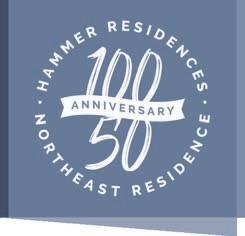
We have the best volunteers! Each one is a much-needed part of living out our mission. Some of our volunteers nurture one-on-one relationships; some "adopt" a home and engage everyone in activities, projects, and outings; some help out with our events or work on special projects. There's something for everyone!
We are thankful to our donors and community partners who have compassion for people with developmental and other disabilities and want to make a difference in their lives. Their generous support has enabled us to continually innovate and grow to meet the changing times—and changing needs—of those we support.
And, of course, there are the families who have entrusted the care and support of their loved ones to us. Whether it was five or 50 years ago, we understand how difficult and important these decisions are and will always be committed to offering those we support our very best for as long as they need us.
Managing Editor: Jennifer L. Hipple
Design Concept & Photography: Barbara Brandt
Editorial Planning Committee: Barbara Brandt
Lin Curran
Sondra Hampton
Jennifer L. Hipple
Cathy Thoma
Ellen Timmerman-Borer
Ginger Venable
Graphic Design: Jenny Larson
Archivist: Rose Rizzi

